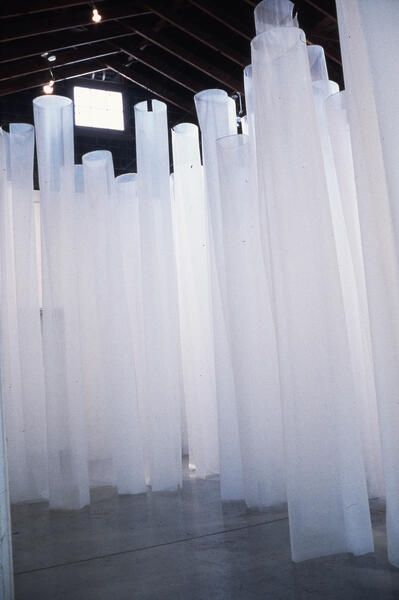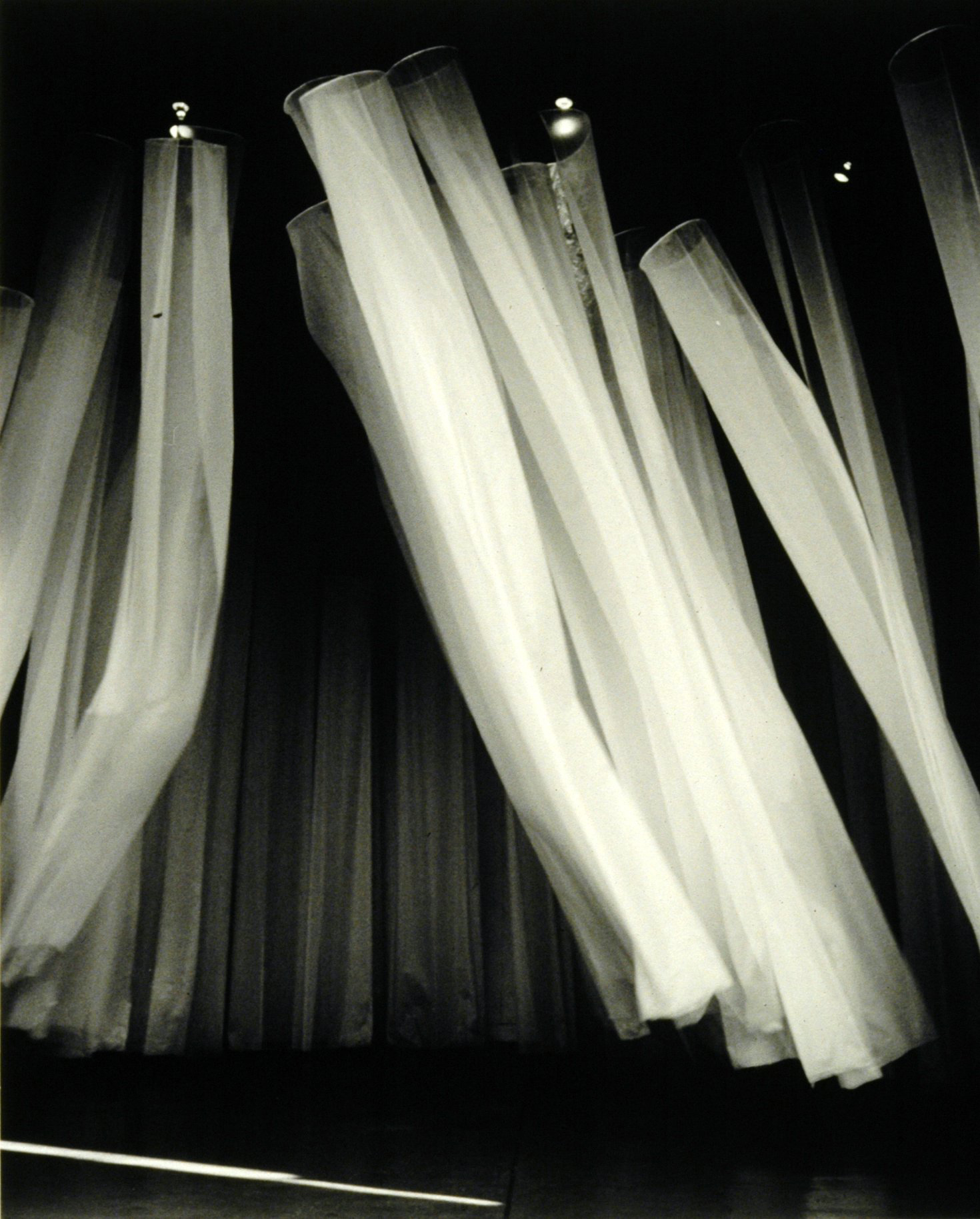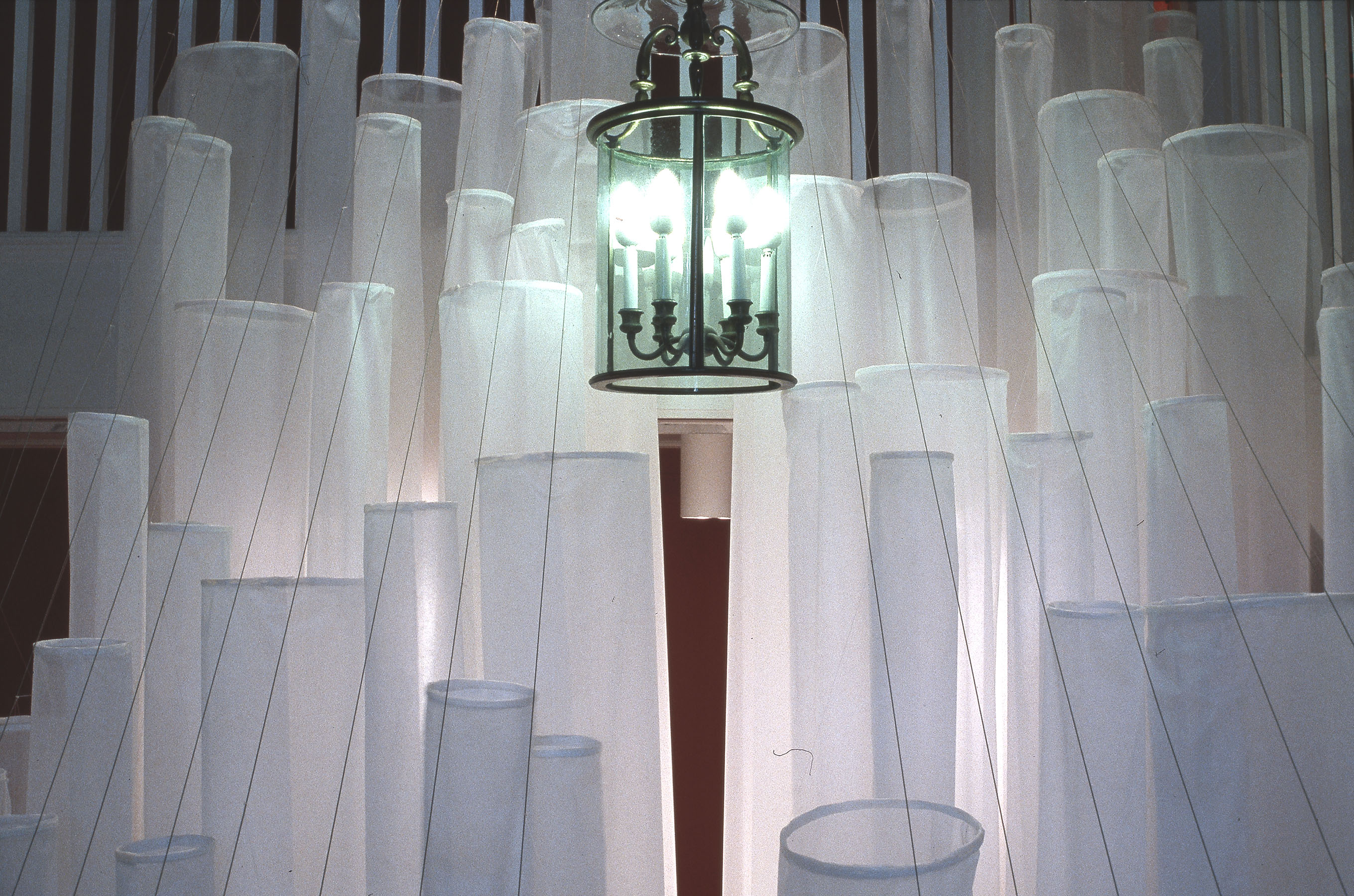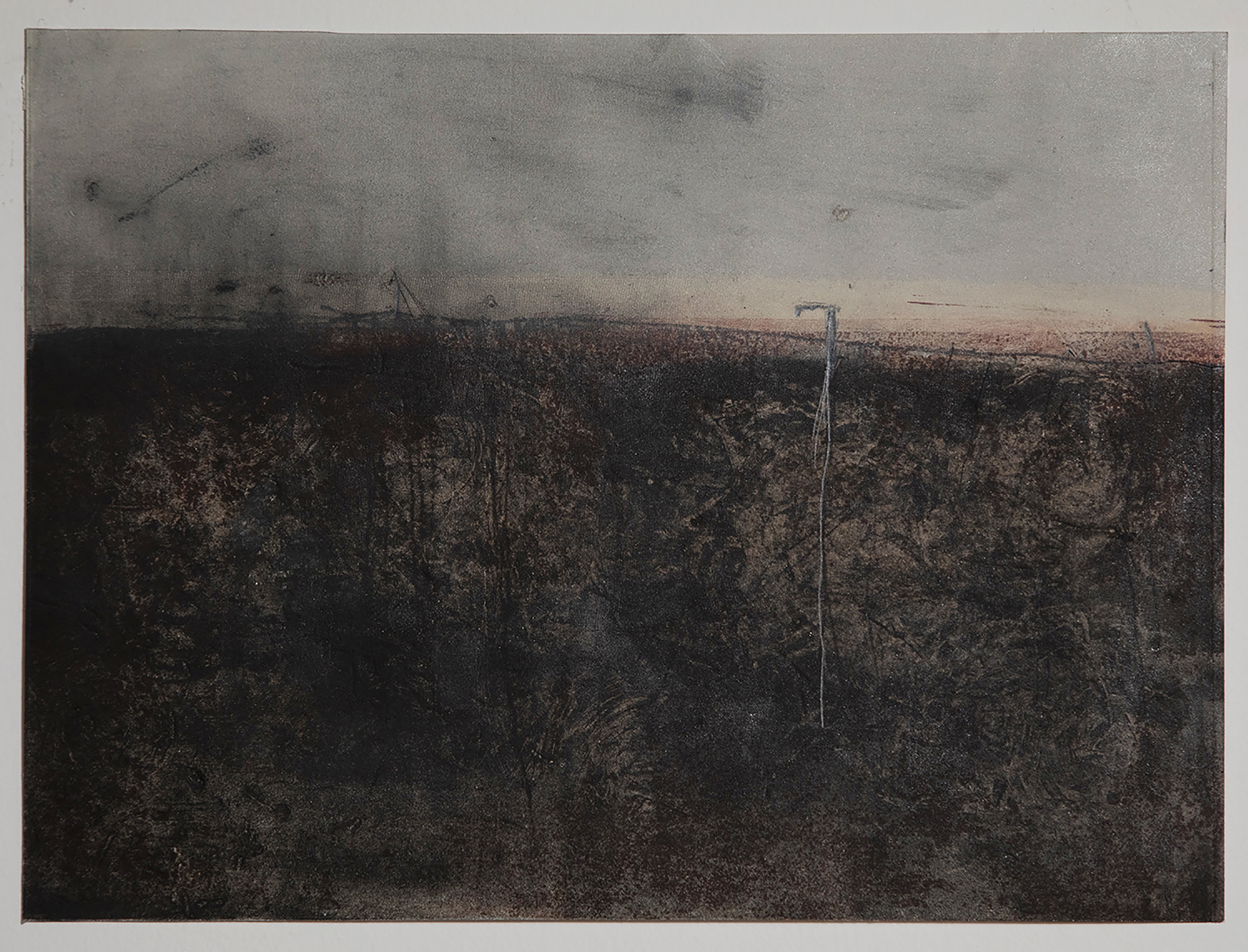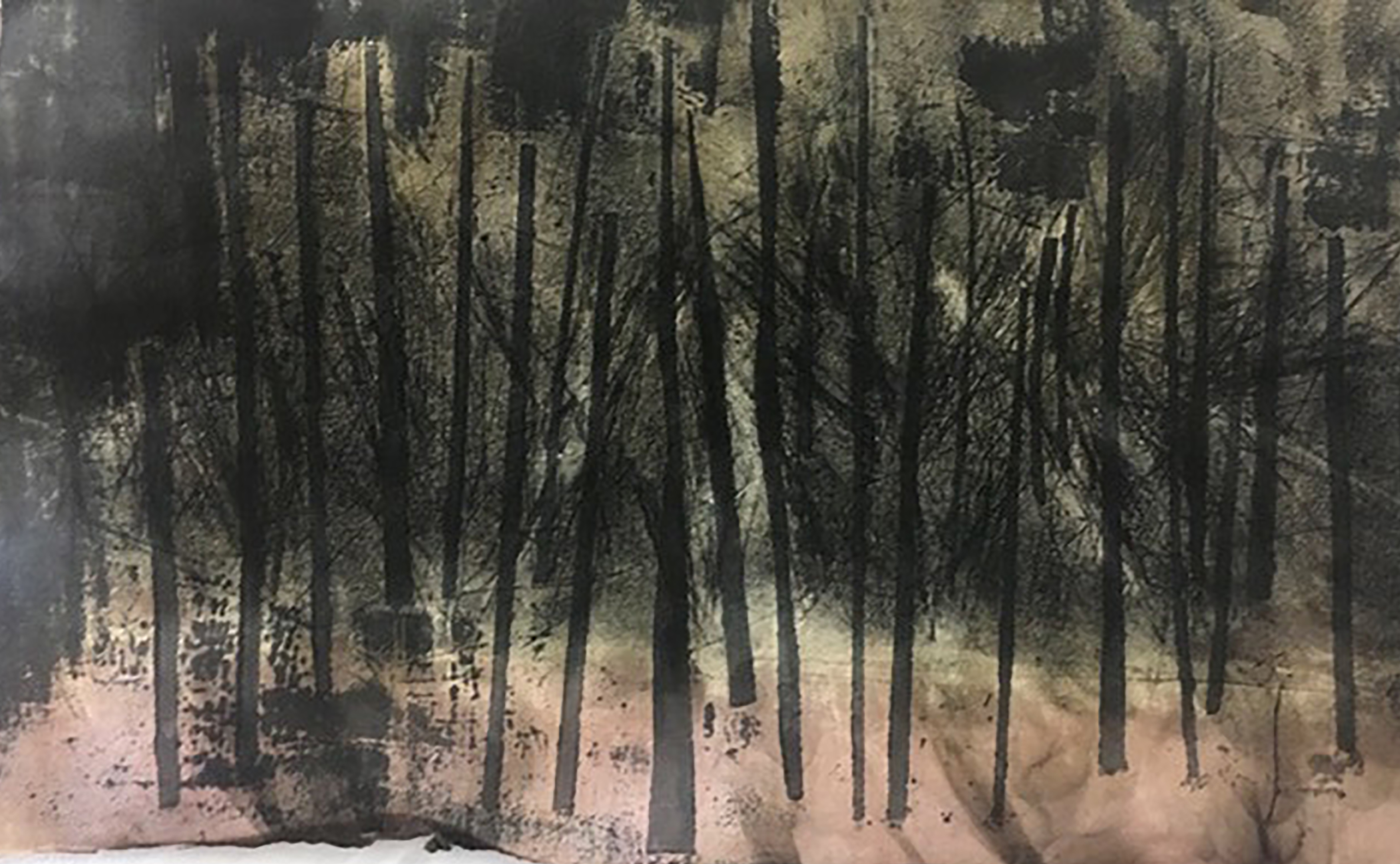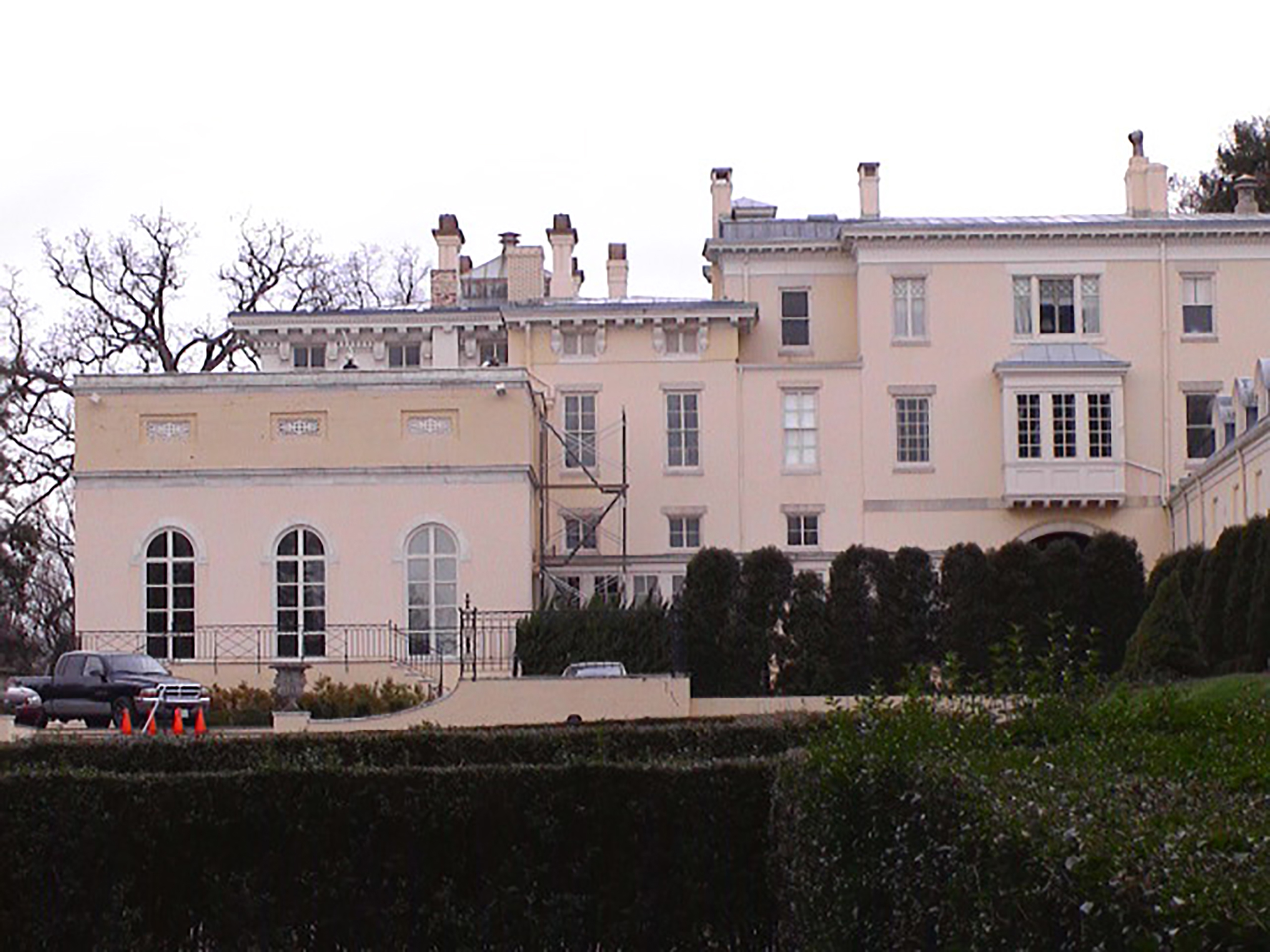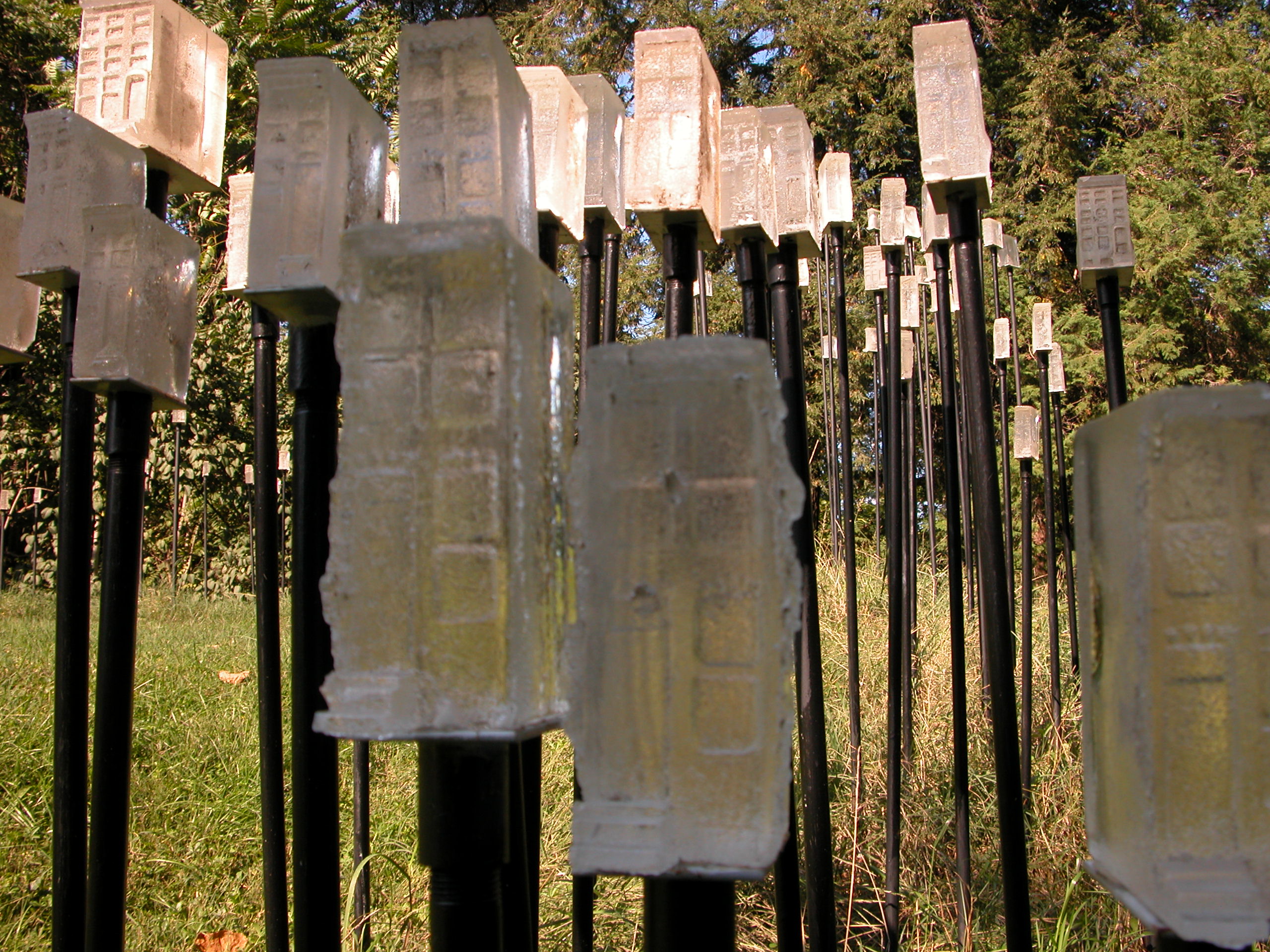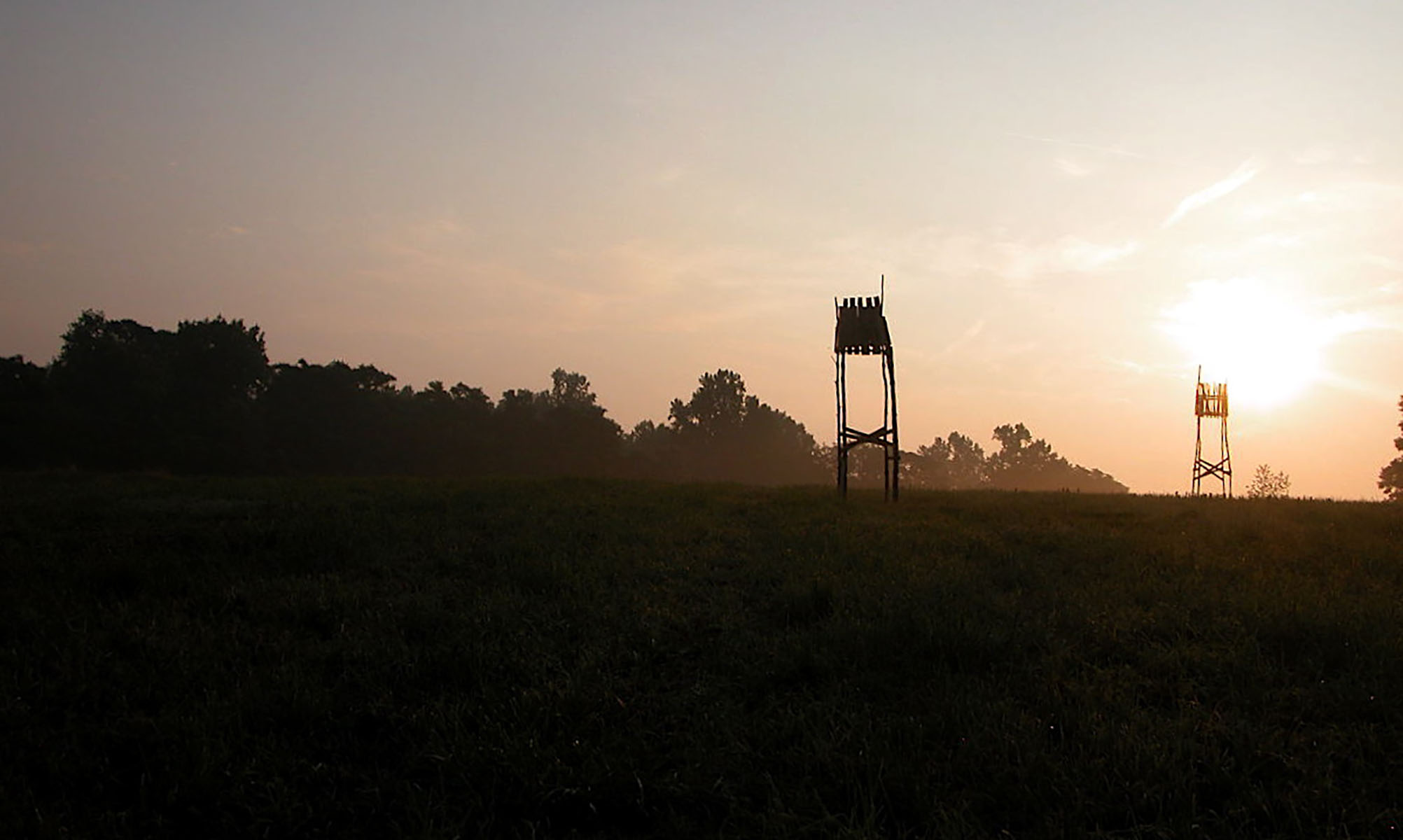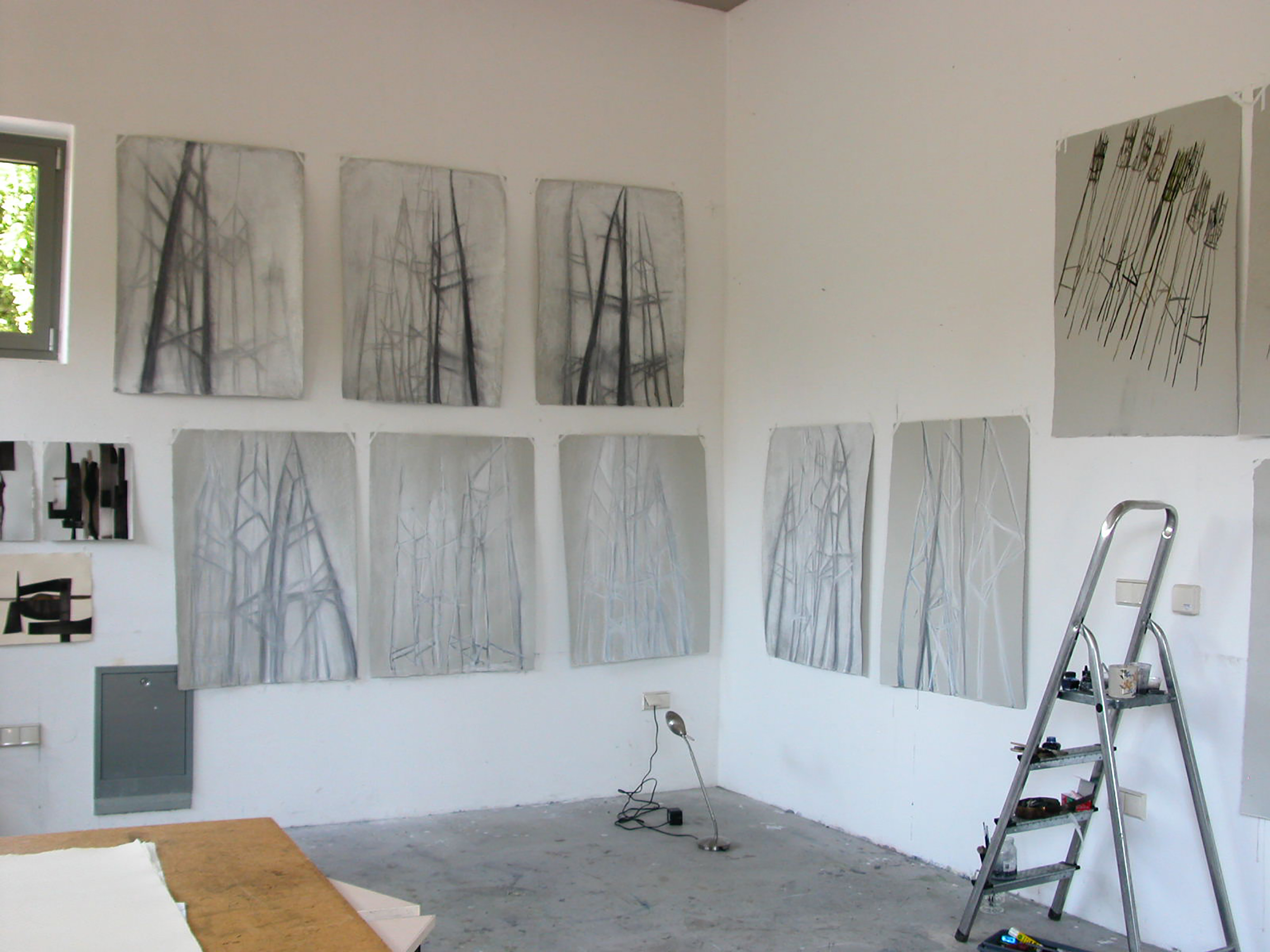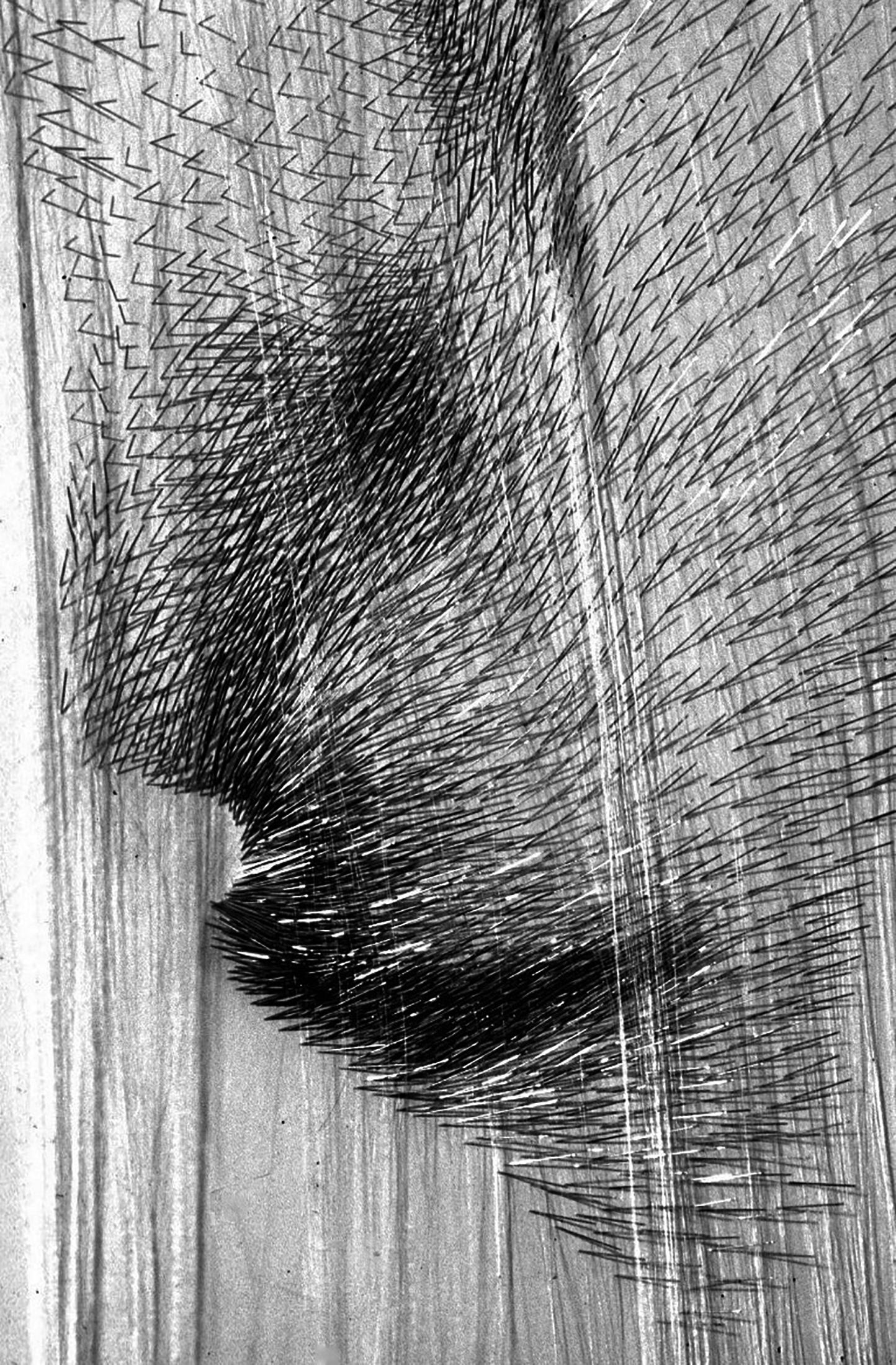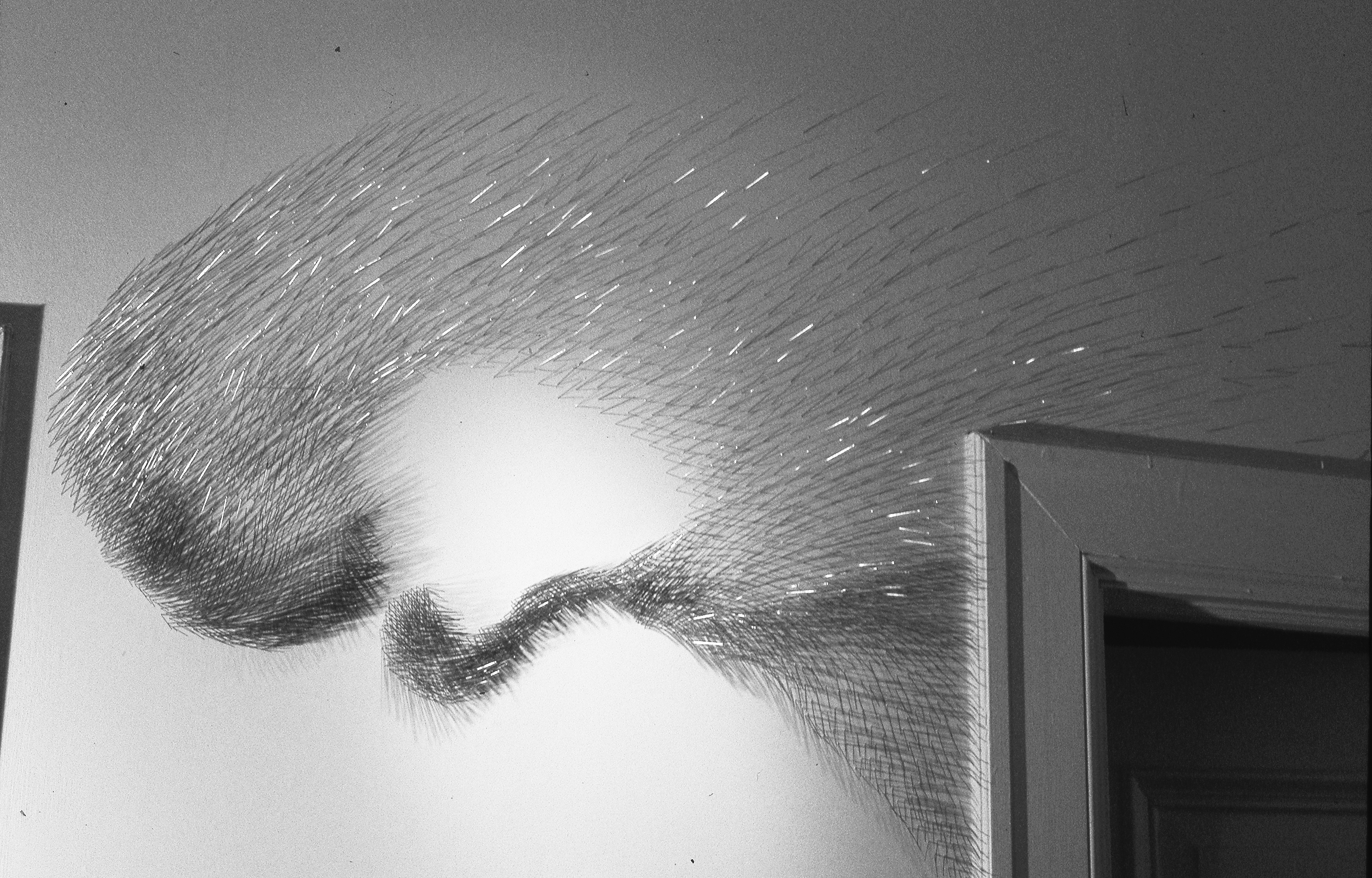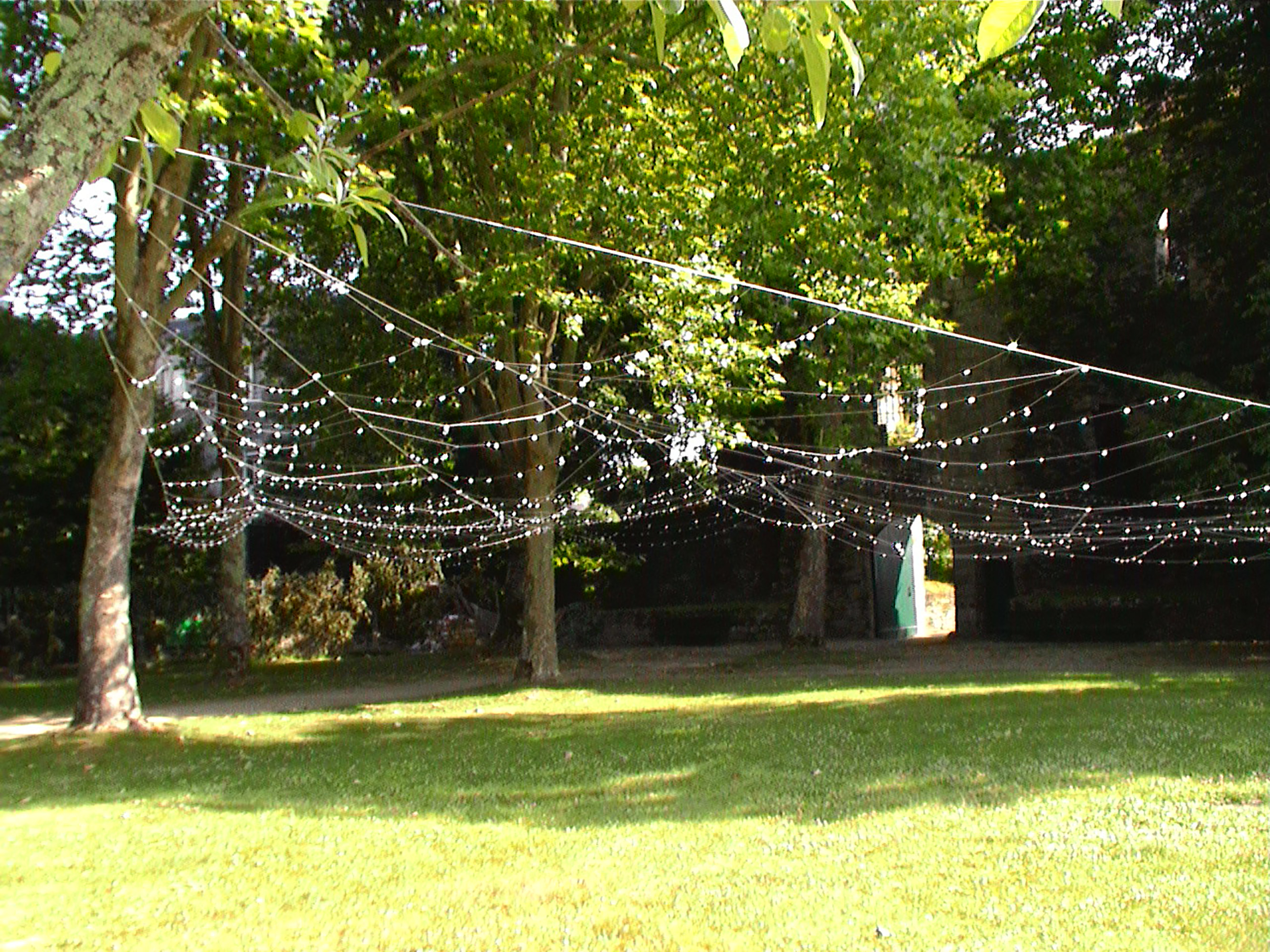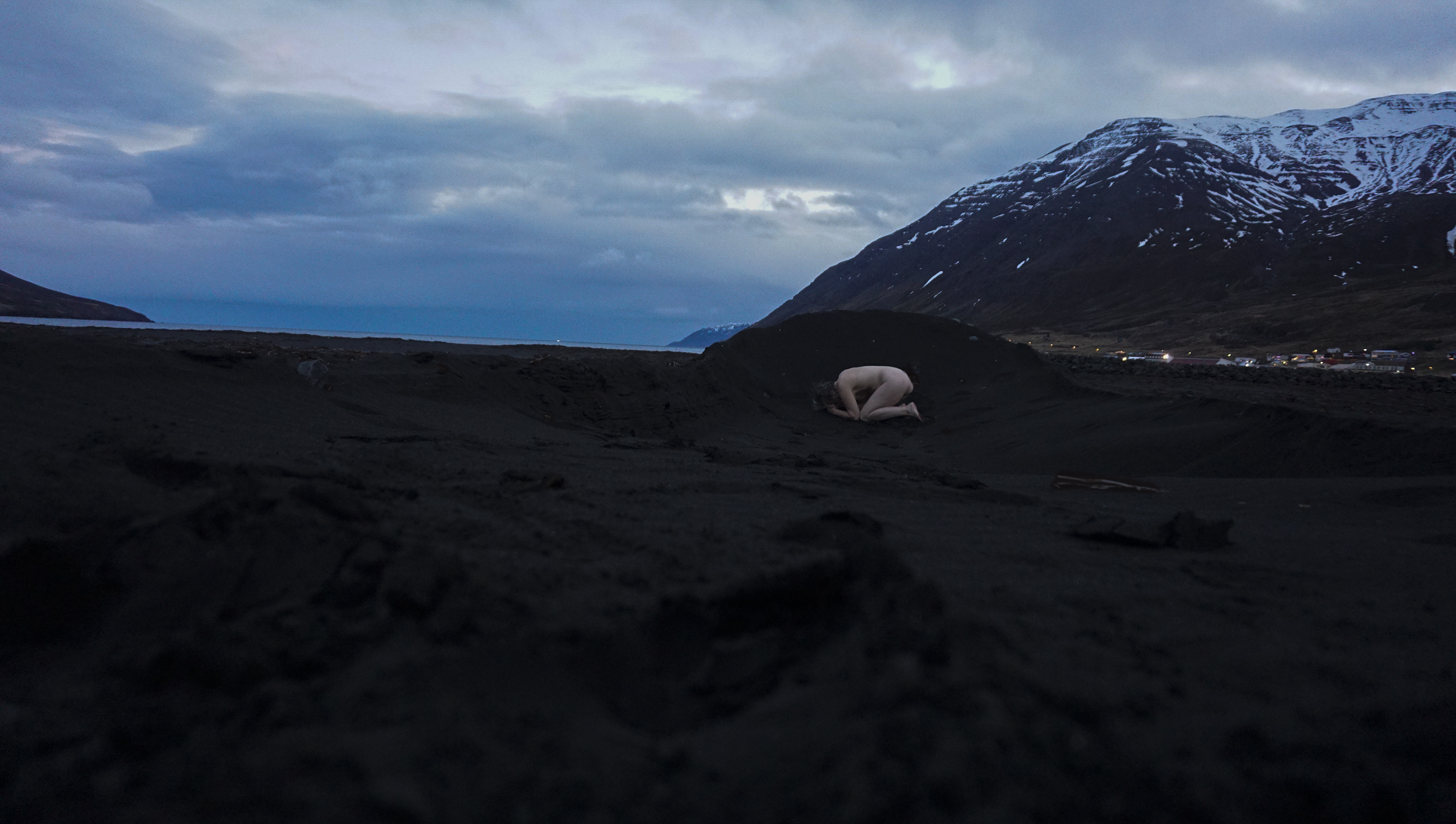Work samples
-
 ClassClass was sited in the Evergreen House garden of Johns Hopkins University in north Baltimore. The installation referenced the relationship between the owner of the Evergreen House, John Work Garrett, president of the Baltimore & Ohio Railroad at the time he bought the house in 1878, and the immigrant railroad workers who lived in the various classes of houses near the rail yards in south Baltimore. The piece consisted of 100 cast glass row-houses in 3 different sizes, each representing different classes of workers’ houses. The Baltimore row-houses near the B&O rail yards were used for models. 100 cast glass “row-houses” on steel poles row-houses - 3 different sizes area of siting: 50ft. x 40ft. row-house heights from 8ft. tall to 15ft. tall
ClassClass was sited in the Evergreen House garden of Johns Hopkins University in north Baltimore. The installation referenced the relationship between the owner of the Evergreen House, John Work Garrett, president of the Baltimore & Ohio Railroad at the time he bought the house in 1878, and the immigrant railroad workers who lived in the various classes of houses near the rail yards in south Baltimore. The piece consisted of 100 cast glass row-houses in 3 different sizes, each representing different classes of workers’ houses. The Baltimore row-houses near the B&O rail yards were used for models. 100 cast glass “row-houses” on steel poles row-houses - 3 different sizes area of siting: 50ft. x 40ft. row-house heights from 8ft. tall to 15ft. tall
About katherine
Baltimore City

Katherine Kavanaugh makes temporary, site-specific, indoor and outdoor installations which sometimes incorporate video projections. She has collaborated with choreographers, composers, and writers. She often works in printmaking and drawing.
Professional activities:
Site-specific installations: Art Museum of the Americas, Organization of American States, Washington, DC; The Klotz Chateau, Rochefort-en-Terre, Brittany, France; The… more
Jump to a project:
aria and canto - two installations
aria was sited in the Camp Gallery of the Virginia Center for the Creative Arts (VCCA) in Amherst, VA.
The gallery was originally a dairy barn built in the 1920's. During the 6 months of the installation's exhibit, individuals and groups performed in the space including the Dance Theater of Lynchberg, The Sweet Briar College choral arts group, poets and writers who were Fellows of the VCCA .
“aria” was a response to
-large luna moths which floated through the barn at night
-the air currents in the barn
-4 silos surrounding the barn
-the neo-classical columns in southern Virginia homes
240 columns of Japanese rayon paper
each column: from 12ft. – 15ft.
barn: 30ft. x 60ft. x 30ft.
The gallery was originally a dairy barn built in the 1920's. During the 6 months of the installation's exhibit, individuals and groups performed in the space including the Dance Theater of Lynchberg, The Sweet Briar College choral arts group, poets and writers who were Fellows of the VCCA .
“aria” was a response to
-large luna moths which floated through the barn at night
-the air currents in the barn
-4 silos surrounding the barn
-the neo-classical columns in southern Virginia homes
240 columns of Japanese rayon paper
each column: from 12ft. – 15ft.
barn: 30ft. x 60ft. x 30ft.
-
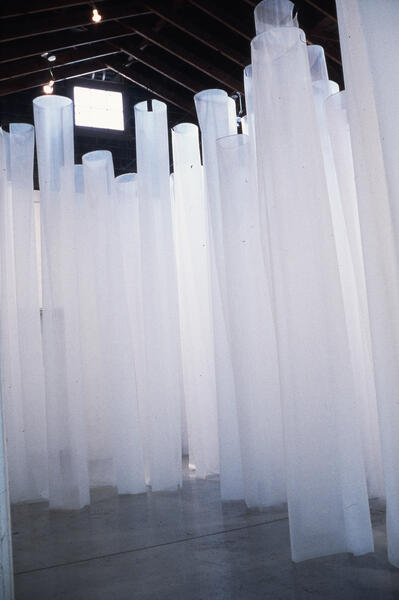 ariaThese 2 pieces -- aria and canto - used an incredibly light and strong Japanese usukuchi rayon paper which responds to the slightest movement of air. aria was sited in the Camp Gallery of the Virginia Center for the Creative Arts in Amherst, VA. The gallery was originally a dairy barn built in the 1920's. I used the barn as a studio the summer before installing the piece. I installed a grid system using steel cables 17 ft. from the floor of the barn structure. The columns were formed by attaching the paper to bent aluminum rods. I then attached monofilament to the columns and clipped them to the grid. 240 columns of Japanese rayon paper each column: 12ft. – 15ft. barn: 30ft. x 60ft. x 30ft. 2001
ariaThese 2 pieces -- aria and canto - used an incredibly light and strong Japanese usukuchi rayon paper which responds to the slightest movement of air. aria was sited in the Camp Gallery of the Virginia Center for the Creative Arts in Amherst, VA. The gallery was originally a dairy barn built in the 1920's. I used the barn as a studio the summer before installing the piece. I installed a grid system using steel cables 17 ft. from the floor of the barn structure. The columns were formed by attaching the paper to bent aluminum rods. I then attached monofilament to the columns and clipped them to the grid. 240 columns of Japanese rayon paper each column: 12ft. – 15ft. barn: 30ft. x 60ft. x 30ft. 2001 -
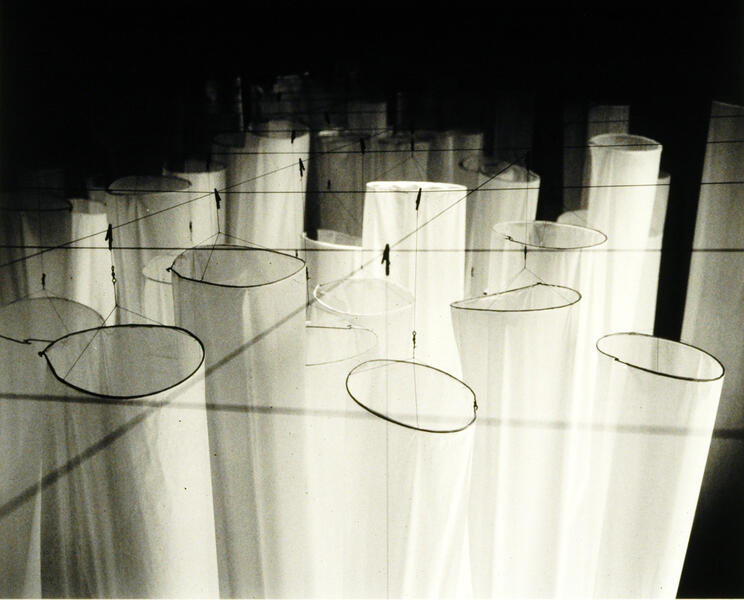 aria from abovearia from above looking down from a "catwalk" around the perimeter of the barn The barn is 30ft.tall X 60ft.long X 30ft. wide with large doors on the front which allowed air to circulate freely in the space animating the paper.
aria from abovearia from above looking down from a "catwalk" around the perimeter of the barn The barn is 30ft.tall X 60ft.long X 30ft. wide with large doors on the front which allowed air to circulate freely in the space animating the paper. -
 aria shaped by air currentsaria in gallery/barn activated by air currents
aria shaped by air currentsaria in gallery/barn activated by air currents -
 aria at nightaria at night through front barn doors
aria at nightaria at night through front barn doors -
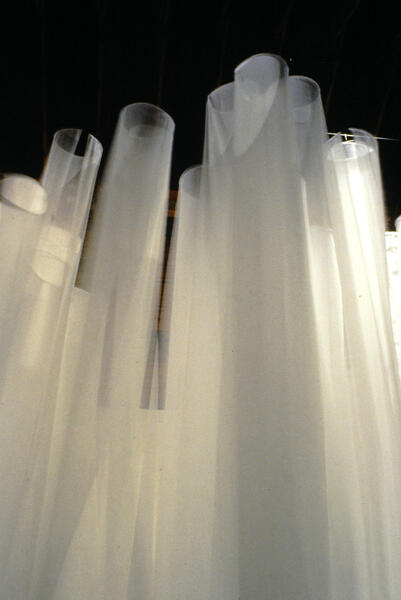 ariaaria - view from center of installation
ariaaria - view from center of installation -
 canto - from second floor landingCanto was sited in the three-story central stairwell of the Museum of the Americas, Organization of American States in Washington, DC. The piece filled the stairwell beginning at the front entrance to the building and continuing upward through the central interior. The installation was viewable on all three levels as visitors ascended or descended the stairs. The rayon paper was chosen for its subtle movements as the slightest air currents caused the whole group of columns to move upwards. Japanese usukuchi rayon paper, steel cable, stairwell 55ft. x 12ft. x 10ft.
canto - from second floor landingCanto was sited in the three-story central stairwell of the Museum of the Americas, Organization of American States in Washington, DC. The piece filled the stairwell beginning at the front entrance to the building and continuing upward through the central interior. The installation was viewable on all three levels as visitors ascended or descended the stairs. The rayon paper was chosen for its subtle movements as the slightest air currents caused the whole group of columns to move upwards. Japanese usukuchi rayon paper, steel cable, stairwell 55ft. x 12ft. x 10ft. -
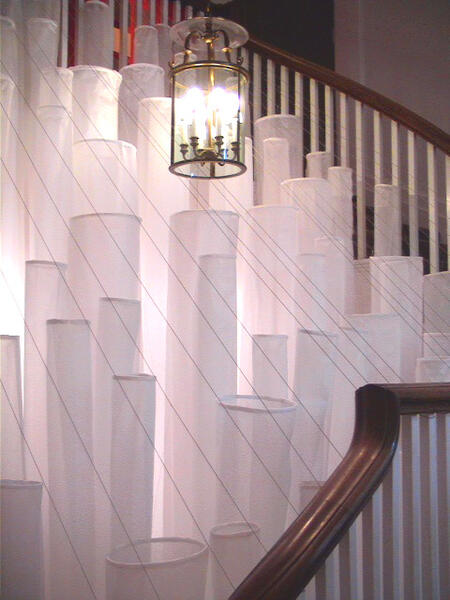 canto - approaching third floor landingcanto - approaching third floor landing at the top of the stairwell
canto - approaching third floor landingcanto - approaching third floor landing at the top of the stairwell -
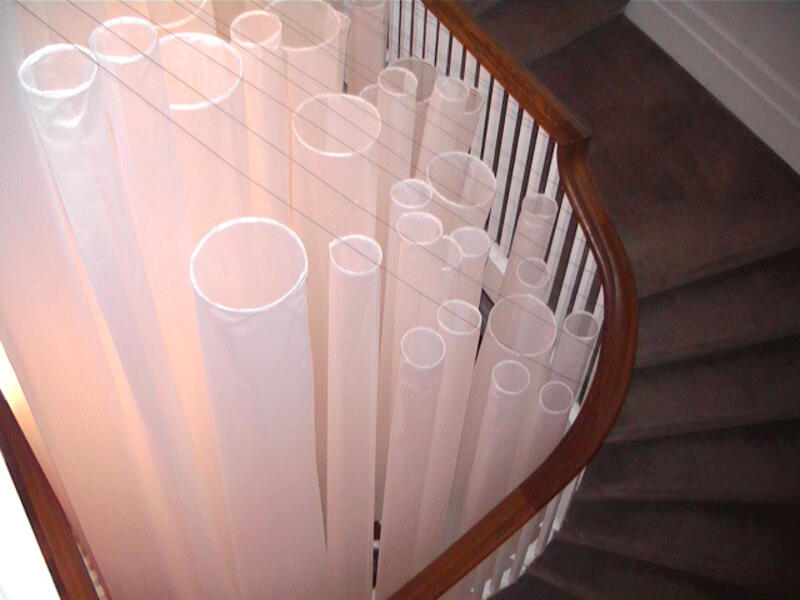 canto - looking down at stairwell from third floorcanto -- looking down at stairwell from third floor
canto - looking down at stairwell from third floorcanto -- looking down at stairwell from third floor -
canto - looking up from second floorcanto - view from second floor
-
 canto - third floorthis is a view from the third and last level
canto - third floorthis is a view from the third and last level
Ravaged
Ravaged
These mono-prints come from a series of 50 prints and are part of a chronological narrative of my emotional response to the unmitigated power of wildfires which began ravaging vast expanses of land and forests in California, Brazil and Australia in the summer and fall of 2019. What began as a series of prints to memorialize the destruction and after-effects of the charred forest-scape, soon turned into more potent imagery. As the fires continued to rage, I began to use actual fire and smoke in the work to show the chaotic frenzy of a world on fire both environmentally and politically.
The world-wide effects of climate change insidiously creep into our lives as we disregard and abuse our planet. Humans have become the victims of forces more potent than what we are able to comprehend or control.
These mono-prints come from a series of 50 prints and are part of a chronological narrative of my emotional response to the unmitigated power of wildfires which began ravaging vast expanses of land and forests in California, Brazil and Australia in the summer and fall of 2019. What began as a series of prints to memorialize the destruction and after-effects of the charred forest-scape, soon turned into more potent imagery. As the fires continued to rage, I began to use actual fire and smoke in the work to show the chaotic frenzy of a world on fire both environmentally and politically.
The world-wide effects of climate change insidiously creep into our lives as we disregard and abuse our planet. Humans have become the victims of forces more potent than what we are able to comprehend or control.
-
Ravaged # 1Ravaged 10' x 10" monoprint akua ink, smoke, soot on BFK paper
-
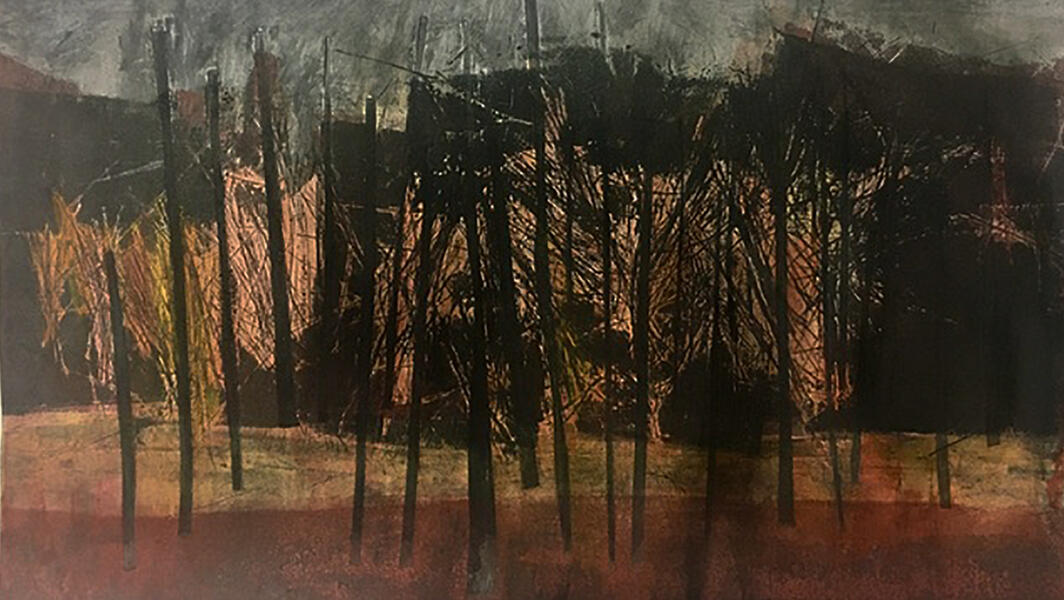 Ravaged #2mono-print 11" x 17" akua ink, smoke, soot on BFK paper
Ravaged #2mono-print 11" x 17" akua ink, smoke, soot on BFK paper -
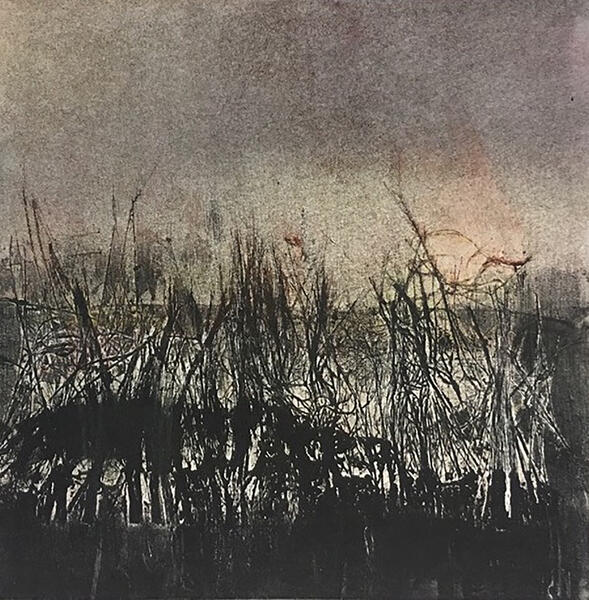 Ravaged #310" x 10" monoprint akua ink, smoke and soot
Ravaged #310" x 10" monoprint akua ink, smoke and soot -
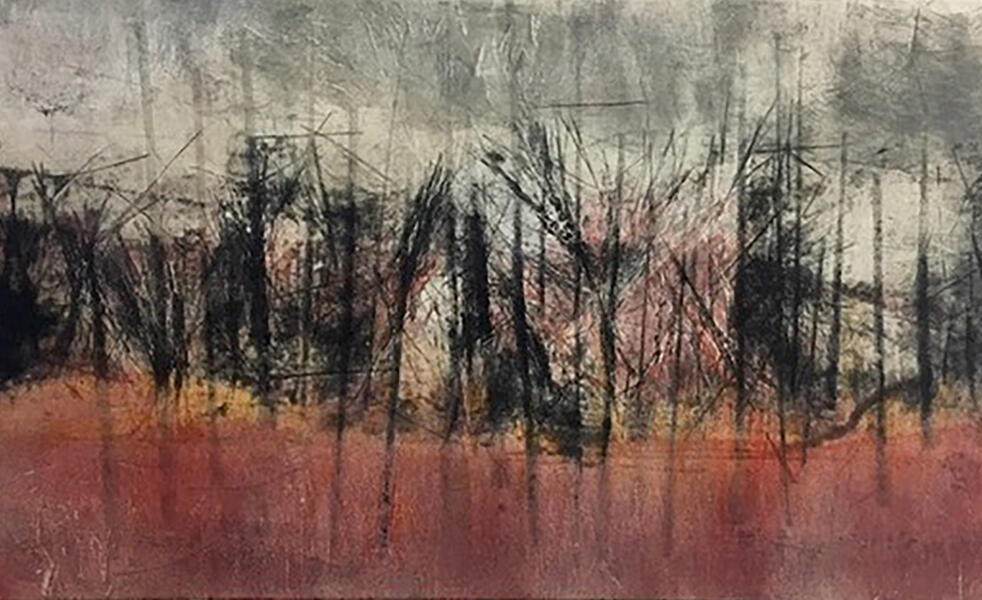 Ravaged #7monoprint, 11" x 17" akua ink, smoke and soot on BFK paper
Ravaged #7monoprint, 11" x 17" akua ink, smoke and soot on BFK paper -
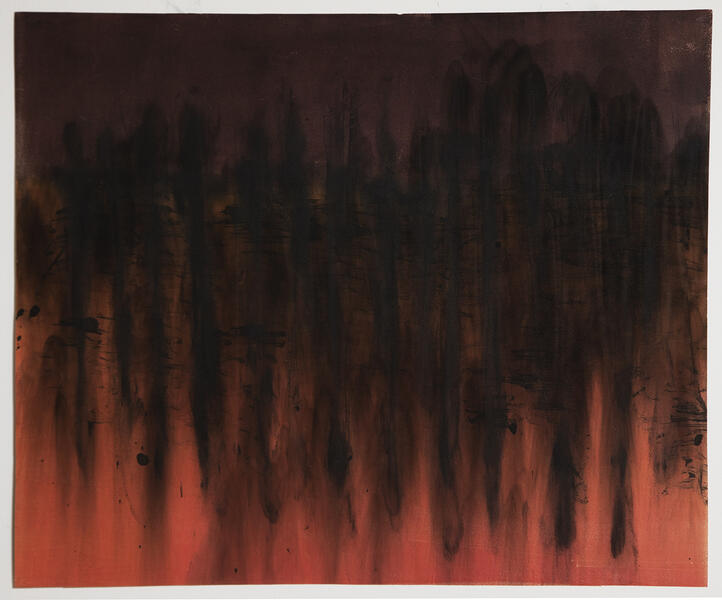 Ravaged #11Ravaged 30" x 22" monoprint akua ink, smoke and soot on BFK paper
Ravaged #11Ravaged 30" x 22" monoprint akua ink, smoke and soot on BFK paper -
 Ravaged #4Ravaged - after the burn monoprint 17" x 20" akua ink, smoke, soot on BFK paper
Ravaged #4Ravaged - after the burn monoprint 17" x 20" akua ink, smoke, soot on BFK paper -
 Ravaged #14Ravaged -- monoprint, using akua ink on BFK paper. Burned - leaving smoke and soot. 11" x 17"
Ravaged #14Ravaged -- monoprint, using akua ink on BFK paper. Burned - leaving smoke and soot. 11" x 17"
Class
Class
Row-houses on tall poles like birdhouses gather across the east garden and perch on top of the hill. Imagine residents of the rowhouses, like birds crossing boundaries, flocking to the country garden at the Evergreen House for fresh air and a view.
Class was sited in the Evergreen House garden of Johns Hopkins University in north Baltimore. The installation referenced the relationship between the owner of the Evergreen House, John Work Garrett, president of the Baltimore & Ohio Railroad at the time he bought the house in 1878, and the immigrant railroad workers who lived in the various classes of houses near the rail yards in south Baltimore. The piece consisted of 100 cast glass row-houses in 3 different sizes, each representing different classes of workers’ houses. The Baltimore row-houses near the B&O rail yards were used for models.
100 cast glass “row-houses” on steel poles
row-houses - 3 different sizes
area of siting: 50ft. x 40ft.
rowhouse heights from 8ft. tall to 15ft. tall
Row-houses on tall poles like birdhouses gather across the east garden and perch on top of the hill. Imagine residents of the rowhouses, like birds crossing boundaries, flocking to the country garden at the Evergreen House for fresh air and a view.
Class was sited in the Evergreen House garden of Johns Hopkins University in north Baltimore. The installation referenced the relationship between the owner of the Evergreen House, John Work Garrett, president of the Baltimore & Ohio Railroad at the time he bought the house in 1878, and the immigrant railroad workers who lived in the various classes of houses near the rail yards in south Baltimore. The piece consisted of 100 cast glass row-houses in 3 different sizes, each representing different classes of workers’ houses. The Baltimore row-houses near the B&O rail yards were used for models.
100 cast glass “row-houses” on steel poles
row-houses - 3 different sizes
area of siting: 50ft. x 40ft.
rowhouse heights from 8ft. tall to 15ft. tall
-
 Evergreen House from back gardenEvergreen House mansion. View from the garden where Class was installed.
Evergreen House from back gardenEvergreen House mansion. View from the garden where Class was installed. -
 ClassClass was sited in the Evergreen House garden of Johns Hopkins University in north Baltimore. The installation referenced the relationship between the owner of the Evergreen House, John Work Garrett, president of the Baltimore & Ohio Railroad at the time he bought the house in 1878, and the immigrant railroad workers who lived in the various classes of houses near the rail yards in south Baltimore. The piece consisted of 100 cast glass row-houses in 3 different sizes, each representing different classes of workers’ houses. The Baltimore row-houses near the B&O rail yards were used for models. 100 cast glass “row-houses” on steel poles row-houses - 3 different sizes area of siting: 50ft. x 40ft. row-house heights from 8ft. tall to 15ft. tall
ClassClass was sited in the Evergreen House garden of Johns Hopkins University in north Baltimore. The installation referenced the relationship between the owner of the Evergreen House, John Work Garrett, president of the Baltimore & Ohio Railroad at the time he bought the house in 1878, and the immigrant railroad workers who lived in the various classes of houses near the rail yards in south Baltimore. The piece consisted of 100 cast glass row-houses in 3 different sizes, each representing different classes of workers’ houses. The Baltimore row-houses near the B&O rail yards were used for models. 100 cast glass “row-houses” on steel poles row-houses - 3 different sizes area of siting: 50ft. x 40ft. row-house heights from 8ft. tall to 15ft. tall -
 Class largest size - merchant classClass -- large The homes of more prosperous working families were larger, airier, and better lit; two or three stories high; mostly 12' to 14' wide, but occasionally 16'; and three bays across. They had a first-floor parlor with a side hall, backed by a dining room, with two bedrooms above.
Class largest size - merchant classClass -- large The homes of more prosperous working families were larger, airier, and better lit; two or three stories high; mostly 12' to 14' wide, but occasionally 16'; and three bays across. They had a first-floor parlor with a side hall, backed by a dining room, with two bedrooms above. -
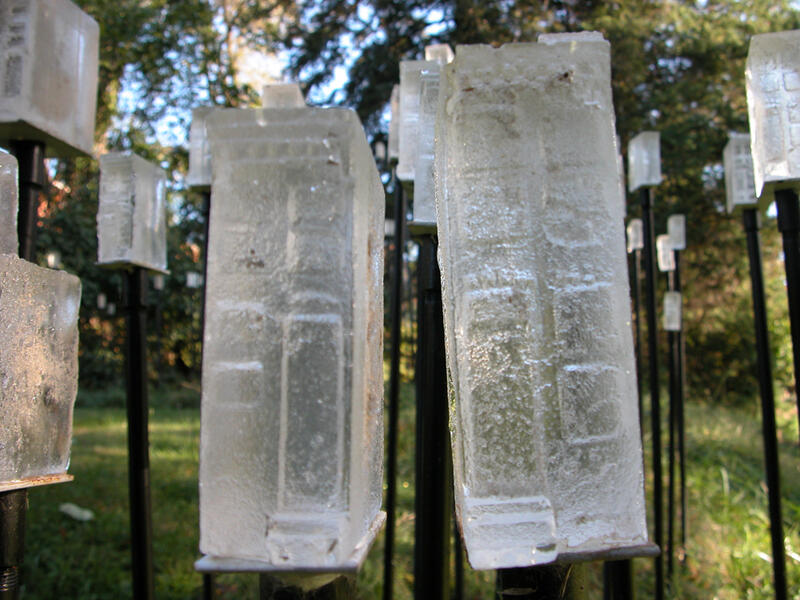 class - two sizesThe row-house on the left is an alley house and was approximately 10 feet wide. In south Baltimore newly arrived railroad workers lived in alley houses-- often large families were crammed into these. The row-house on the right is an example of where railroad workers lived as they acquired higher paying jobs.
class - two sizesThe row-house on the left is an alley house and was approximately 10 feet wide. In south Baltimore newly arrived railroad workers lived in alley houses-- often large families were crammed into these. The row-house on the right is an example of where railroad workers lived as they acquired higher paying jobs. -
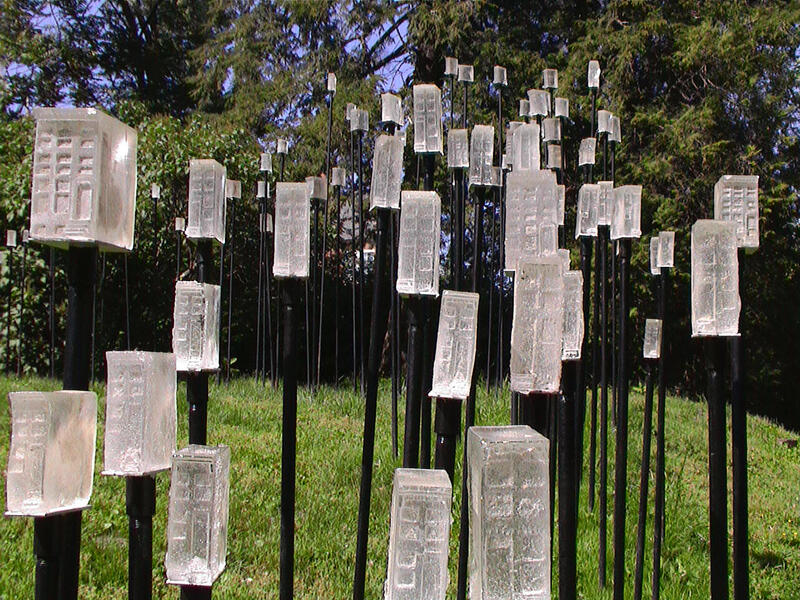 ClassA flock of row-houses.
ClassA flock of row-houses. -
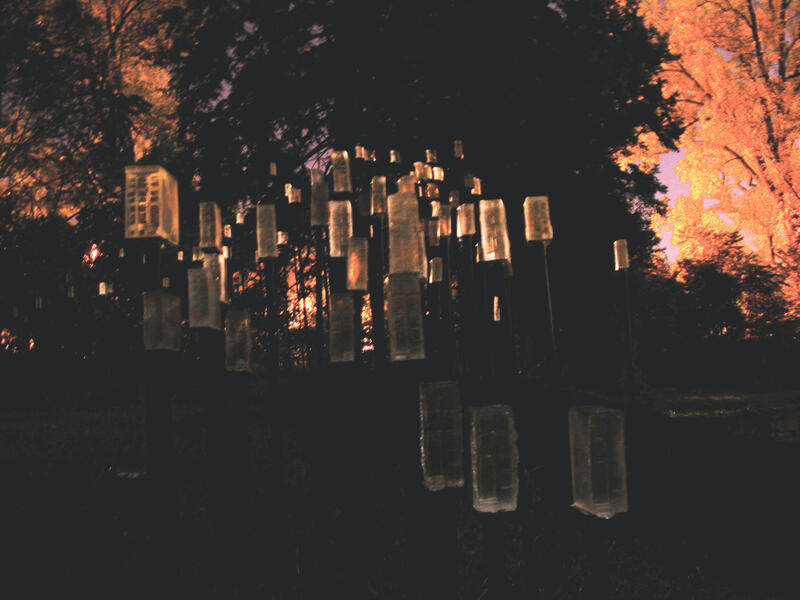 Class at nightClass at night
Class at nightClass at night -
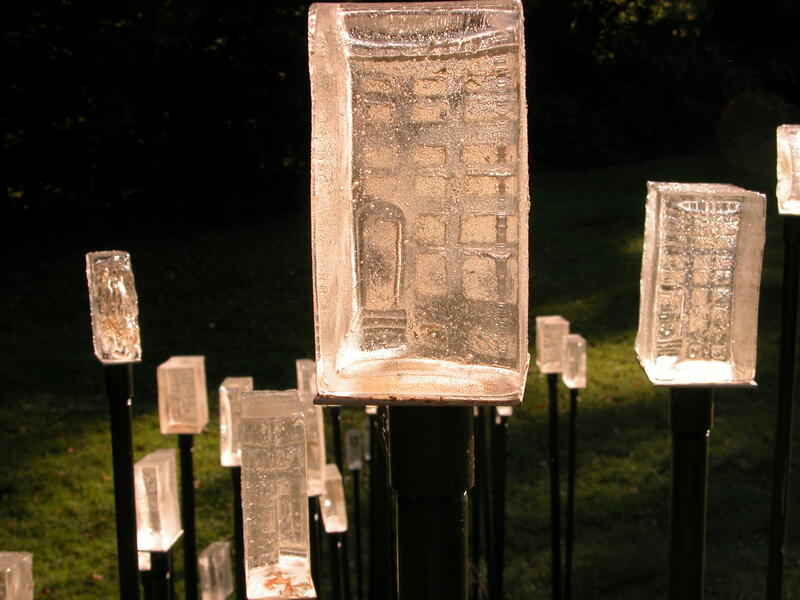 class - view from behindview from the back of rowhouses
class - view from behindview from the back of rowhouses
Nine Wooden Towers
Images of towers began seeping into my work as drawings. They showed up casually at first then with a kind of urgency. When they amassed into a large group of prints and drawings, I felt compelled to build them in the landscape. “Nine Wooden Towers” was an installation built in a large field using downed trees and scrap lumber. The towers I’m interested in are not modern telecommunication towers or urban skyscrapers. They are raw and primal and built by hand. They are scrapped together by a need to piece a puzzle, to find an answer, to settle the longing.
Review of Nine Wooden Towers___________________
It seems impossible to encounter Katherine Kavanaugh’s nine Gothic wooden tower structures, arranged elliptically and rising from a recently mowed field on this Virginia farmstead turned arts colony, and not be struck by a series of compelling analogies: the guard towers of internment and concentration camps; prison watchtowers; the burning towers of Troy; the World Trade Center towers in flames. Less austerely, they recall the rickety play forts of childhood where, even as children, we learned to deny the history of our invasion, instead play-acting early settlers defending themselves against the indigenous people who preceded us. Kavanaugh’s installation also evokes the strategy of setting signal fires to warn farming peoples of invaders, perhaps in the Bronze Age, or, in more peaceful times, some ancient solar ritual celebrating the growing season as spring evolves into summer and solstice approaches. In 2007, when living in the United States increasingly means being subjected to unprecedented government scrutiny as this regime continues to erect structures of surveillance and control—structures that “tower” over the heads of most of its citizens—it is necessary to remind us all of the impermanence of such constructions, however imposing, as well as of our own responsibility to dismantle them before they come to seem a natural part of the landscape. Like Kavanaugh’s own towers, conceived of and fabricated in less than a week’s time, such structures seem to have arisen overnight and without warning; they are as mesmerizing as they are eerily familiar.
Susan Gubernat, poet
Assistant Professor, English department
California State University, Hayward, CA
Review of Nine Wooden Towers___________________
It seems impossible to encounter Katherine Kavanaugh’s nine Gothic wooden tower structures, arranged elliptically and rising from a recently mowed field on this Virginia farmstead turned arts colony, and not be struck by a series of compelling analogies: the guard towers of internment and concentration camps; prison watchtowers; the burning towers of Troy; the World Trade Center towers in flames. Less austerely, they recall the rickety play forts of childhood where, even as children, we learned to deny the history of our invasion, instead play-acting early settlers defending themselves against the indigenous people who preceded us. Kavanaugh’s installation also evokes the strategy of setting signal fires to warn farming peoples of invaders, perhaps in the Bronze Age, or, in more peaceful times, some ancient solar ritual celebrating the growing season as spring evolves into summer and solstice approaches. In 2007, when living in the United States increasingly means being subjected to unprecedented government scrutiny as this regime continues to erect structures of surveillance and control—structures that “tower” over the heads of most of its citizens—it is necessary to remind us all of the impermanence of such constructions, however imposing, as well as of our own responsibility to dismantle them before they come to seem a natural part of the landscape. Like Kavanaugh’s own towers, conceived of and fabricated in less than a week’s time, such structures seem to have arisen overnight and without warning; they are as mesmerizing as they are eerily familiar.
Susan Gubernat, poet
Assistant Professor, English department
California State University, Hayward, CA
-
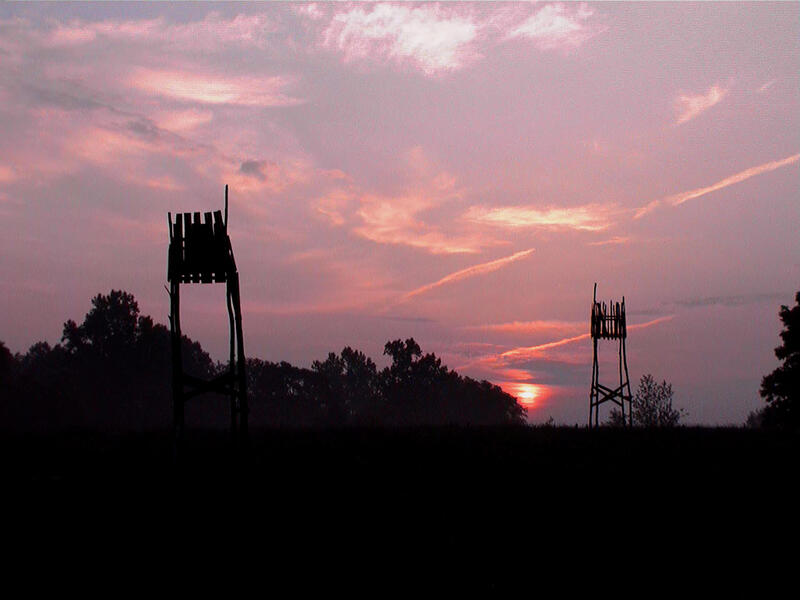 Nine Wooden Towers“Nine Wooden Towers” was a site-specific installation completed June 2007 in a field at the Virginia Center for Creative Arts, Amherst, Virginia. Constructed of scavenged scrap wooden pallets and sapling poles, they are arranged elliptically in a 15 acre hay field. They have many references including Medieval watch towers, prison guard towers, the towers of internment and concentration camps. In silence they speak of surveillance
Nine Wooden Towers“Nine Wooden Towers” was a site-specific installation completed June 2007 in a field at the Virginia Center for Creative Arts, Amherst, Virginia. Constructed of scavenged scrap wooden pallets and sapling poles, they are arranged elliptically in a 15 acre hay field. They have many references including Medieval watch towers, prison guard towers, the towers of internment and concentration camps. In silence they speak of surveillance -
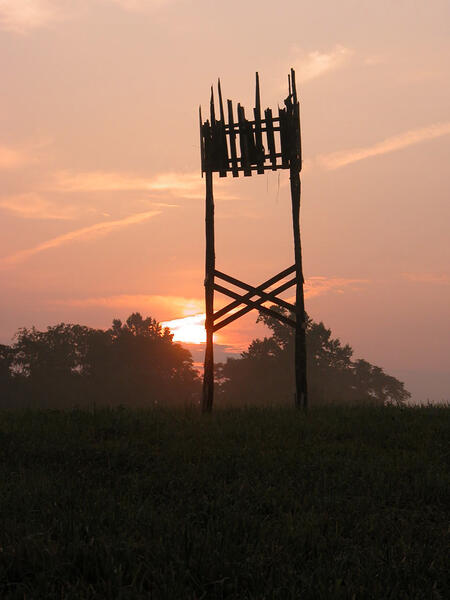 Tower #8
Tower #8 -
 Tower in long landscape.jpg
Tower in long landscape.jpg -
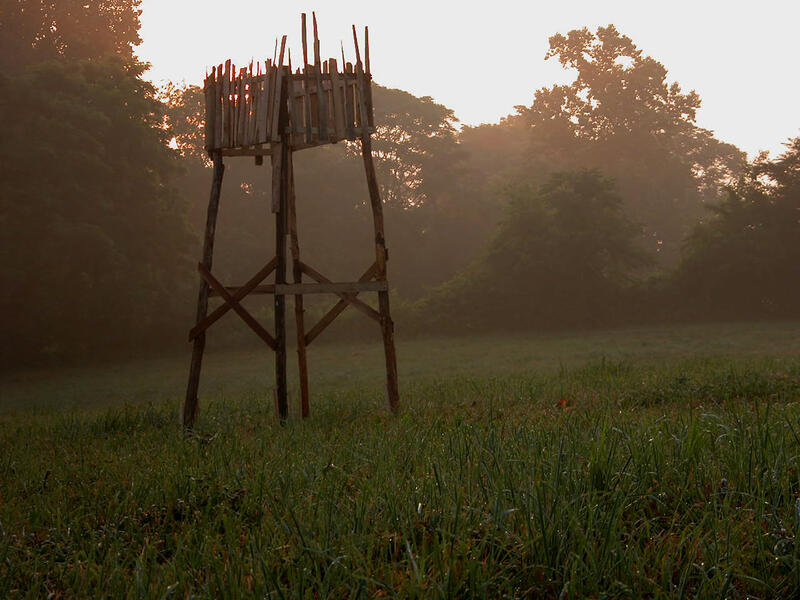 Tower#6
Tower#6 -
Nine Wooden Towers
-
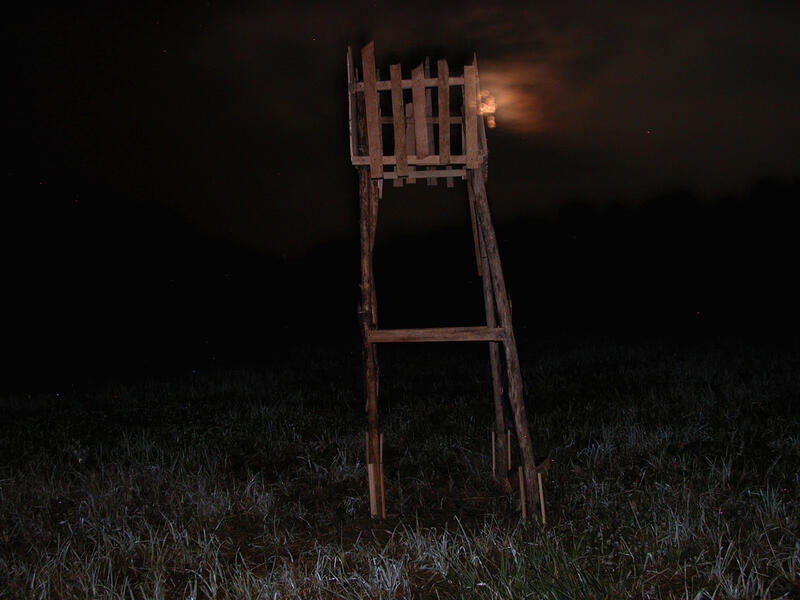 Tower#10
Tower#10 -
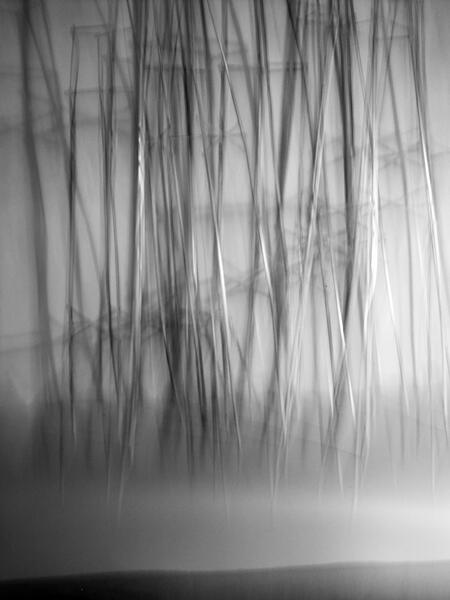 photo -- built bamboo structureI constructed a series of tall towers out of thin bamboo, and photographed then. printed -- 60 inches x 36 inches
photo -- built bamboo structureI constructed a series of tall towers out of thin bamboo, and photographed then. printed -- 60 inches x 36 inches -
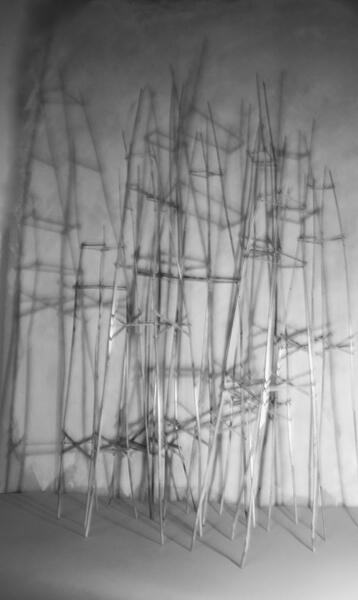 photo -- built bamboo structurephoto of towers constructed using bamboo printed at: 60 inches x 36 inches
photo -- built bamboo structurephoto of towers constructed using bamboo printed at: 60 inches x 36 inches -
 studio drawings of towersstudio drawings, charcoal 36Inches x 24 inches
studio drawings of towersstudio drawings, charcoal 36Inches x 24 inches -
Nine Wooden Towers
in Search of
in Search of
An installation at Stevenson University, Stevenson, MD using sapling poles and rope with projected video of woman running through Nine Wooden Towers.
poles - 16 ft tall
platform - 4ft x 4ft
in Search of
a poem by Jennifer Wallace
We seek a form, a shape — adequate enough: the kitchen table, mother’s leg — the thing
to hoist ourselves. Barely arrived, we already aim for the sun.
Piling our maple blocks, we are makers from the start. A log laid across the stream,
the bark boat with its leaf sail, a ladder to a platform in the pines. Something
makes us want to cross, to climb. Something we are born with invents a larger lens, metal wings,
rockets. We scheme.
Our plans — torn and pasted — made, remade. The secret covered, uncovered and covered again.
Higher, ever higher. To be grazed by the hawk’s wing; fed,
like Elijah, by the ravens’ horny beaks. A vigil, and whatever we might surmise about blue-black space,
the limits of what we see.
What is wished for? To be tree-like, god-close? Outside of time? We are preoccupied with prominence.
The point, through whatever haze or light,
always farthest from “what is.” It’s not enough to see the sun and stars, but to be one of them. Or
beyond, the furthest place. Something in us knows
there’s something we must find. If only we could find the form, build the thing. What kind of wood? How
many steps? Where to tie the ropes? Spindly or spired?
And the other ones, those we make with hope or the nails of loss and grief… the thing through which,
with which, we might arrive above our flesh and blood,
above the moss, outside of air. Would it be benevolent? Malign? A place we don’t need eyes to see.
Unfixed, unlike the towers we make to get us there.
A place to startle us. As in love’s moment. Would we let down our guard? Forget who or what we seek?
We would arrive at the deepest eye, the one
that would let itself be entered, be taken in and taken. What would we, then, what could we, name the
seeker? The carrier of thought and all its structures?
What is known—at last: a certain rust and beetle-bitten ruin, the sure reunion with the roots of all we’ve ever feared or dreamed.
An installation at Stevenson University, Stevenson, MD using sapling poles and rope with projected video of woman running through Nine Wooden Towers.
poles - 16 ft tall
platform - 4ft x 4ft
in Search of
a poem by Jennifer Wallace
We seek a form, a shape — adequate enough: the kitchen table, mother’s leg — the thing
to hoist ourselves. Barely arrived, we already aim for the sun.
Piling our maple blocks, we are makers from the start. A log laid across the stream,
the bark boat with its leaf sail, a ladder to a platform in the pines. Something
makes us want to cross, to climb. Something we are born with invents a larger lens, metal wings,
rockets. We scheme.
Our plans — torn and pasted — made, remade. The secret covered, uncovered and covered again.
Higher, ever higher. To be grazed by the hawk’s wing; fed,
like Elijah, by the ravens’ horny beaks. A vigil, and whatever we might surmise about blue-black space,
the limits of what we see.
What is wished for? To be tree-like, god-close? Outside of time? We are preoccupied with prominence.
The point, through whatever haze or light,
always farthest from “what is.” It’s not enough to see the sun and stars, but to be one of them. Or
beyond, the furthest place. Something in us knows
there’s something we must find. If only we could find the form, build the thing. What kind of wood? How
many steps? Where to tie the ropes? Spindly or spired?
And the other ones, those we make with hope or the nails of loss and grief… the thing through which,
with which, we might arrive above our flesh and blood,
above the moss, outside of air. Would it be benevolent? Malign? A place we don’t need eyes to see.
Unfixed, unlike the towers we make to get us there.
A place to startle us. As in love’s moment. Would we let down our guard? Forget who or what we seek?
We would arrive at the deepest eye, the one
that would let itself be entered, be taken in and taken. What would we, then, what could we, name the
seeker? The carrier of thought and all its structures?
What is known—at last: a certain rust and beetle-bitten ruin, the sure reunion with the roots of all we’ve ever feared or dreamed.
-
 in Search ofWooden tower made with saplings and sisal rope sited in gallery of Stevenson University. Video contains image from Nine Wooden Towers. 15ft tall by 4ft x 4ft base
in Search ofWooden tower made with saplings and sisal rope sited in gallery of Stevenson University. Video contains image from Nine Wooden Towers. 15ft tall by 4ft x 4ft base -
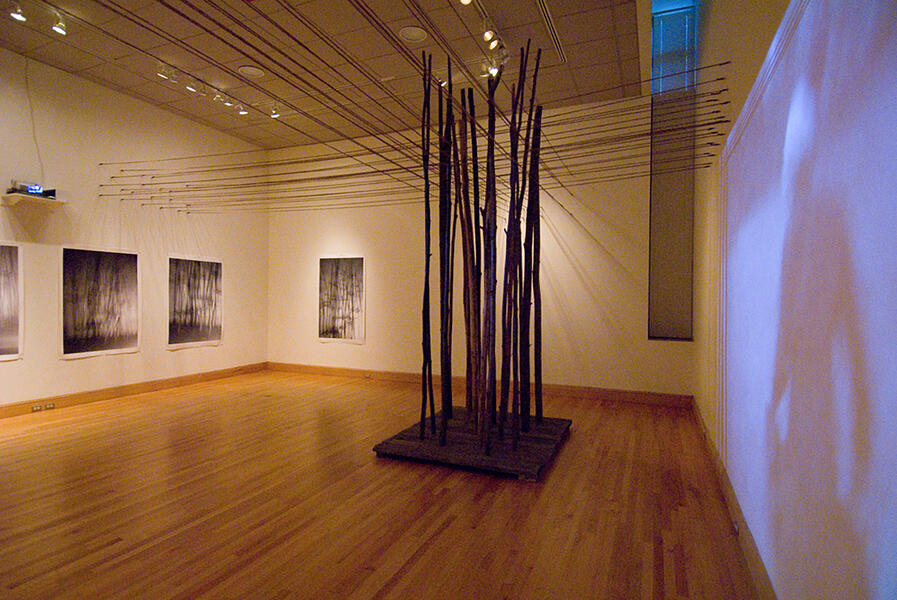 in Search ofWooden saplings, video projection with sound
in Search ofWooden saplings, video projection with sound -
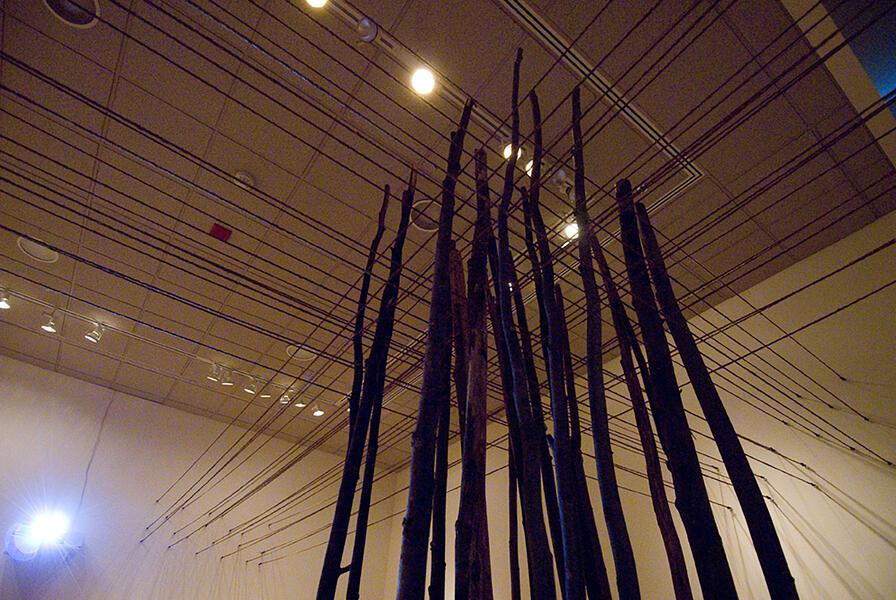 in Search ofWooden tower made with saplings and sisal rope sited in gallery of Stevenson University. Video contains image from Nine Wooden Towers. 15ft tall by 4ft x 4ft base
in Search ofWooden tower made with saplings and sisal rope sited in gallery of Stevenson University. Video contains image from Nine Wooden Towers. 15ft tall by 4ft x 4ft base -
 in Search ofView through "tower" with photographs of individual built towers behind.
in Search ofView through "tower" with photographs of individual built towers behind.
Needles
I was provoked by imagining a wall as an impermanent and penetrable border. In the scope of time, a wall creates a temporary boundary in a temporary space.
I liked the way the needles were nearly invisible in a room and could be easily missed until the viewer was at a particular angle so that the needles magically appeared in all of their massiveness. As I stood silently observing viewers entering the space, many came in, missed the piece and walked out wondering what it was all about.
9,000 - 10,000 sewing needles into wall
often threaded with monofilament
I liked the way the needles were nearly invisible in a room and could be easily missed until the viewer was at a particular angle so that the needles magically appeared in all of their massiveness. As I stood silently observing viewers entering the space, many came in, missed the piece and walked out wondering what it was all about.
9,000 - 10,000 sewing needles into wall
often threaded with monofilament
-
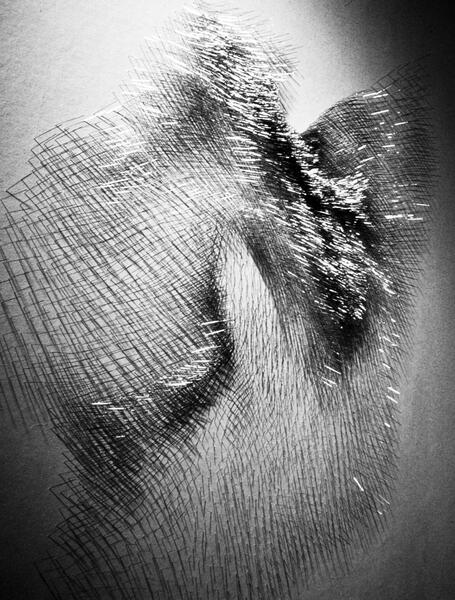 Swarm - detaildetail of 9,000 sewing needles into 12ft. x 20ft. wall
Swarm - detaildetail of 9,000 sewing needles into 12ft. x 20ft. wall -
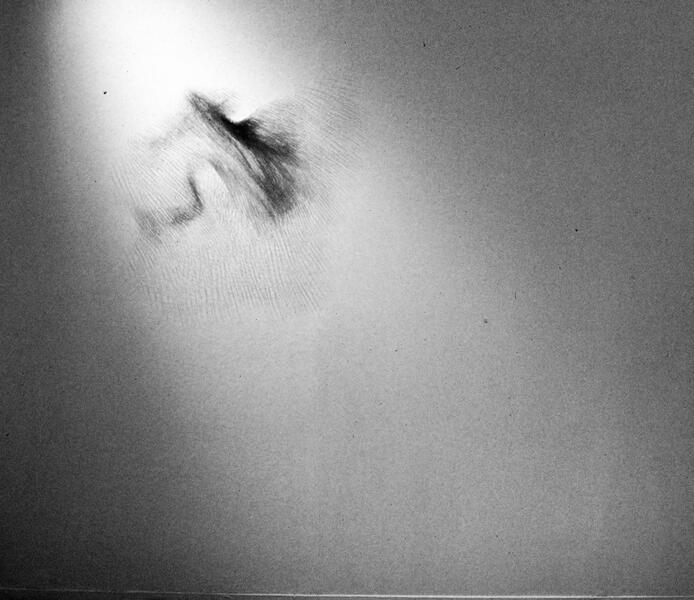 Swarm9,000 needles into 12ft. x 20ft. wall
Swarm9,000 needles into 12ft. x 20ft. wall -
 Whorl9,000 threaded sewing needles into wall needles threaded with monofilament on 12ft. x 14ft. wall I liked how the monofilament moved with the slightest whisper of a breath as viewers came close
Whorl9,000 threaded sewing needles into wall needles threaded with monofilament on 12ft. x 14ft. wall I liked how the monofilament moved with the slightest whisper of a breath as viewers came close -
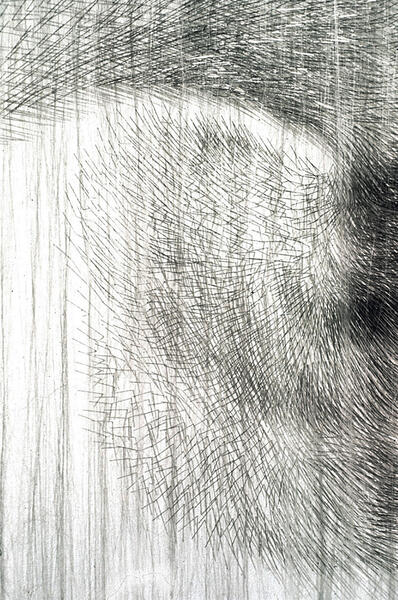 Whorl - detaildetail of Whorl threaded needles into wall surface
Whorl - detaildetail of Whorl threaded needles into wall surface -
 Breath - detalBreath 5,000 threaded needles into wall
Breath - detalBreath 5,000 threaded needles into wall -
 untitled -- needlesNeedles between doorways
untitled -- needlesNeedles between doorways
Web
Installed at the Klotz Chateau in Rochefort-en-Terre, Brittany, France - an artist residency.
This installation was a response to the hundreds of spider webs found in the grasses and outbuildings at the chateau. It was constructed in the large entrance courtyard to the chateau so that visitors could walk into/under it. At night ambient light caught the beads and monofilament to mimick the constellation charts of Northern France.
Steel cable, monofilament, 2500 faceted glass beads, clover
15ft. (h) x 300ft.(l) x 85ft. (w)
This installation was a response to the hundreds of spider webs found in the grasses and outbuildings at the chateau. It was constructed in the large entrance courtyard to the chateau so that visitors could walk into/under it. At night ambient light caught the beads and monofilament to mimick the constellation charts of Northern France.
Steel cable, monofilament, 2500 faceted glass beads, clover
15ft. (h) x 300ft.(l) x 85ft. (w)
-
 WebInstalled in the courtyard of the Klotz Chateau in Rochefort-en-Terre, Brittany, France. 2000 faceted glass beads attached to monofilament and hung from steel cables.
WebInstalled in the courtyard of the Klotz Chateau in Rochefort-en-Terre, Brittany, France. 2000 faceted glass beads attached to monofilament and hung from steel cables. -
Web -- detail of faceted glass beadsdetail of faceted glass beads, attached to monofilament, knotted on steel cables which were hung from trees surrounding Chateau courtyard
-
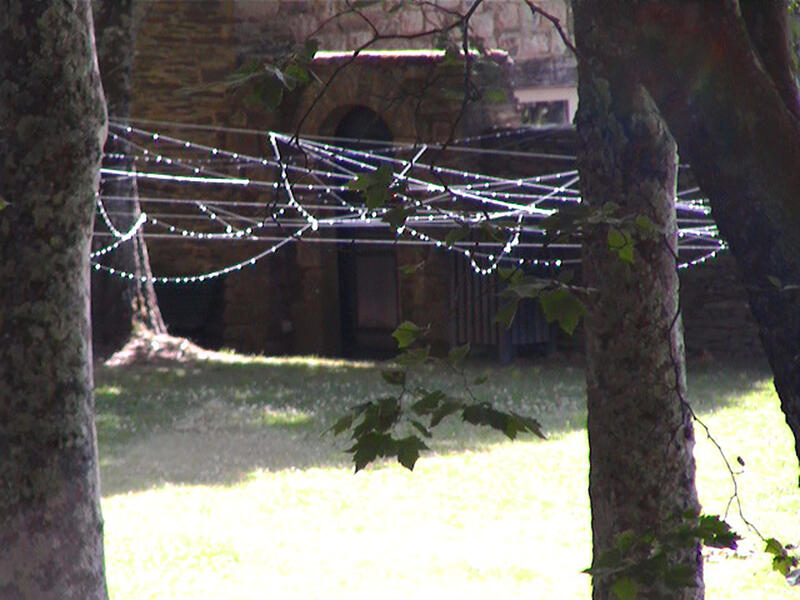 Web - in courtyard of Klotz Chateau
Web - in courtyard of Klotz Chateau -
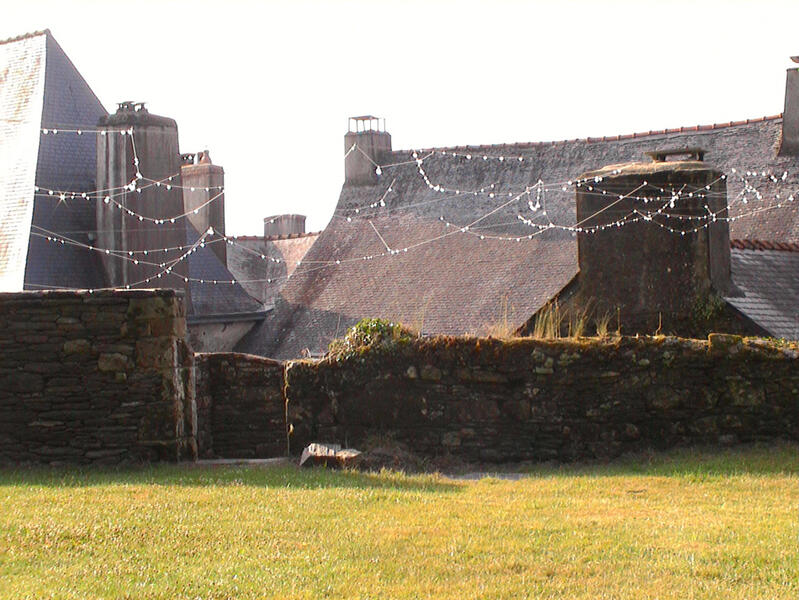 Web - in courtyard of Klotz ChateauWeb - in courtyard of Klotz Chateau
Web - in courtyard of Klotz ChateauWeb - in courtyard of Klotz Chateau -
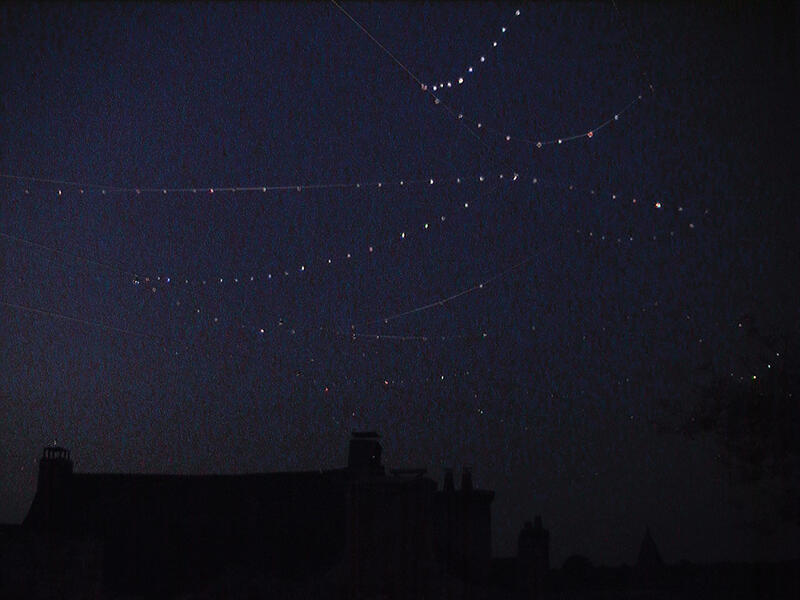 Web at night
Web at night -
breton laceThis installation was a response to the hundreds of spider webs found in the grasses and outbuildings at the Klotz Chateau in Rochefort-en-Terre, Brittany, France. It was constructed in the large entrance courtyard to the chateau so that visitors could walk into/under it. At night ambient light caught the beads and monofilament to mimic the constellation charts of Northern France. Steel cable, monofilament, 2500 faceted glass beads, clover 15ft. (h) x 300ft.(l) x 85ft. (w)
-
breton fishing line showing knot work
Iceland - photographs
I spent the months of December 2016 and January 2017 in a remote artist residency in a small town of Olafsfjodorur, Iceland. The town was in a fjord with black sand beches, 19 miles from the Artctic Circle. Black basalt cliffs surrounded the area. At the Winter solstice the sun rose at 11:45 a.m. and set at 2:45 p.m.
The constant darkness gave me a perspective on timelessness and was a challenge to understanding the psychological weight of darkness. The topography was breathtaking and visually foreign.
-
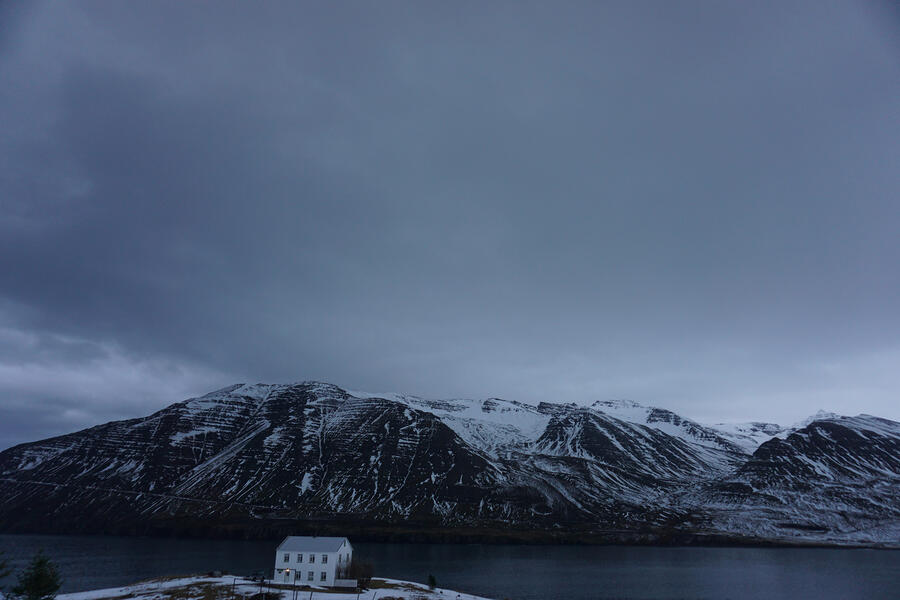 Dark WinterDark Winter -- photograph printed size: 48" x 30"
Dark WinterDark Winter -- photograph printed size: 48" x 30" -
 Dark TownDark Town photograph -- Olafsfjodorur, Iceland printed - 60' x 28"
Dark TownDark Town photograph -- Olafsfjodorur, Iceland printed - 60' x 28" -
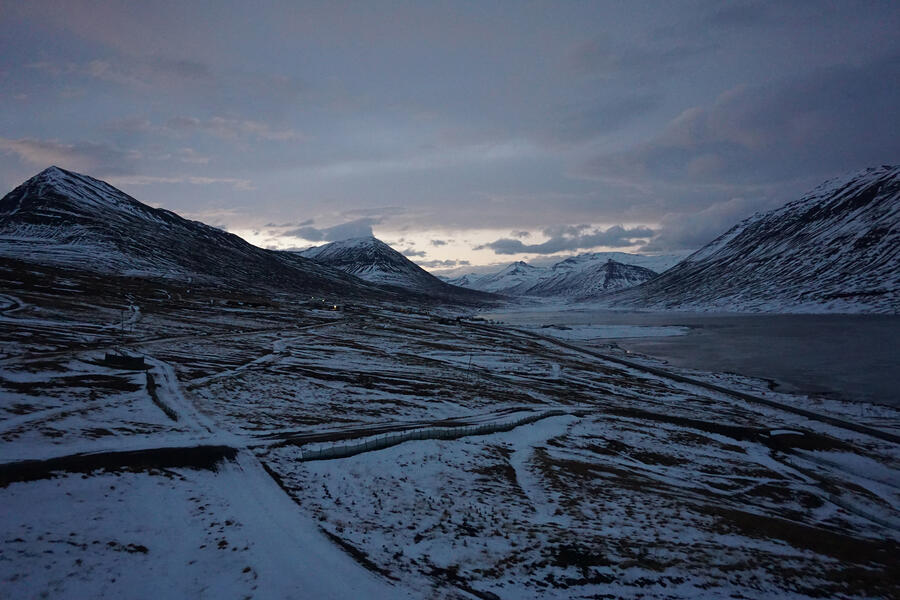 Dark Winter #2Landscapre around Olafsfjordur, Iceland
Dark Winter #2Landscapre around Olafsfjordur, Iceland -
 Beach with Black Sandcrouching figure in carved out black sand dune
Beach with Black Sandcrouching figure in carved out black sand dune -
View toward OlafsfjodorurOlafsfjdorur, Iceland Photograph
-
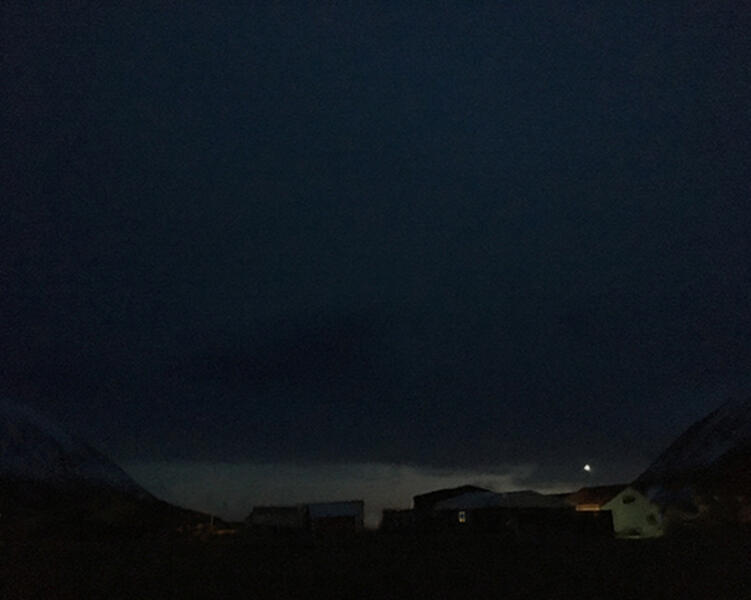 Dark Town #3Dark Town #2 photograph
Dark Town #3Dark Town #2 photograph
Iceland - Earth out of Balance
Earth Out of Balance
Skammdegi (Dark Winter), an artist residency, in Olafsfjordor, North Iceland in December and January 2016 - 17.
The two sculptural pieces, “Rupture” and “Dis-coordinate” together form an installation titled “Earth Out of Balance” which presents a narrative about the political and environmental shifts and ruptures of our time.
“Rupture” uses the sphere (circle) to represent the world-wide environmental degradation of the planet. While “Dis-coordinate” uses the orderly mapping of latitude and longitude (drawn on the wall) with a distorted superimposed, grid structure representing the shifting relationships of chaos and order.
total size - 8 ft. x 20ft. x 1 ft.
Skammdegi (Dark Winter), an artist residency, in Olafsfjordor, North Iceland in December and January 2016 - 17.
The two sculptural pieces, “Rupture” and “Dis-coordinate” together form an installation titled “Earth Out of Balance” which presents a narrative about the political and environmental shifts and ruptures of our time.
“Rupture” uses the sphere (circle) to represent the world-wide environmental degradation of the planet. While “Dis-coordinate” uses the orderly mapping of latitude and longitude (drawn on the wall) with a distorted superimposed, grid structure representing the shifting relationships of chaos and order.
total size - 8 ft. x 20ft. x 1 ft.
-
Earth out of Balance.JPGEarth Out of Balance 2 pieces (Rupture and Discoordinate) sea kelp and drawing with found object both -- 8 ft x 16 ft. x 1 ft
-
RuptureRupture, 2017 72” x 84” x14” dried sea kelp One part of 2 part piece
-
Discoordinate#2. Discoordinate, 2017 44” x 91” x 21” wall drawing and found object
-
Rupture - detaildetail of Rupture -- made with dried sea kelp
-
 Snarl and RootsSnarl on left Roots on right Both of these pieces were formed from hauling wet kelp from the beaches to my studio, and drying them and shaping them over time. Snarl 5 ft. x 5 ft. Roots 3 ft x 3ft
Snarl and RootsSnarl on left Roots on right Both of these pieces were formed from hauling wet kelp from the beaches to my studio, and drying them and shaping them over time. Snarl 5 ft. x 5 ft. Roots 3 ft x 3ft -
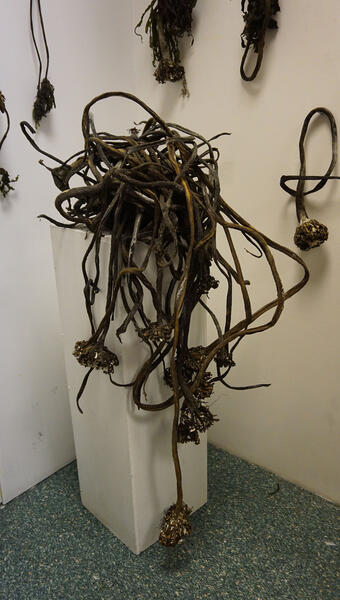 Snarl - detail"Snarl", 2017 53” x 38” x 33” dried sea kelp from Arctic Ocean
Snarl - detail"Snarl", 2017 53” x 38” x 33” dried sea kelp from Arctic Ocean -
kelp dryingkelp drying
